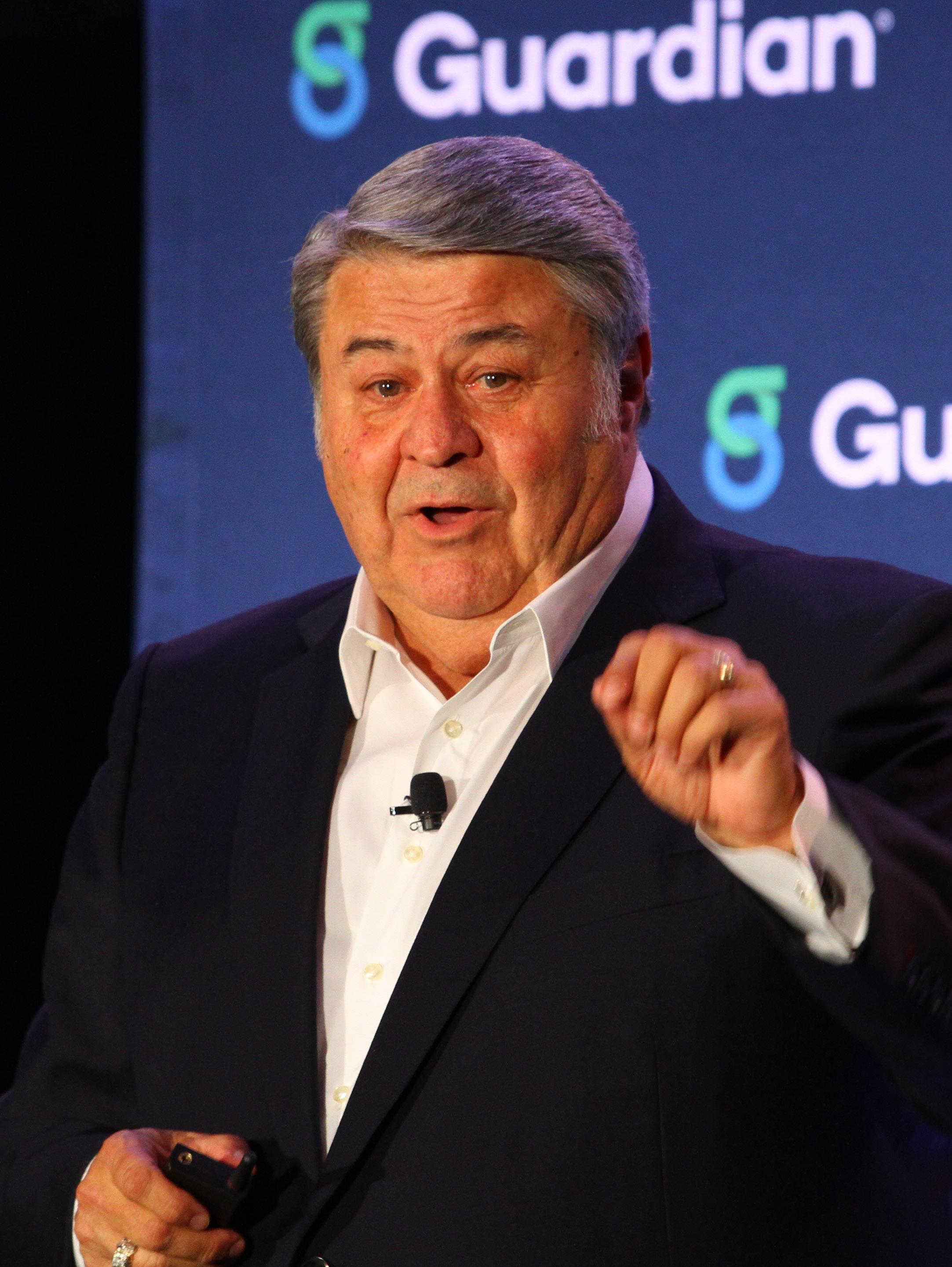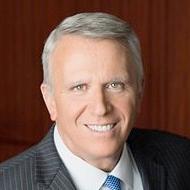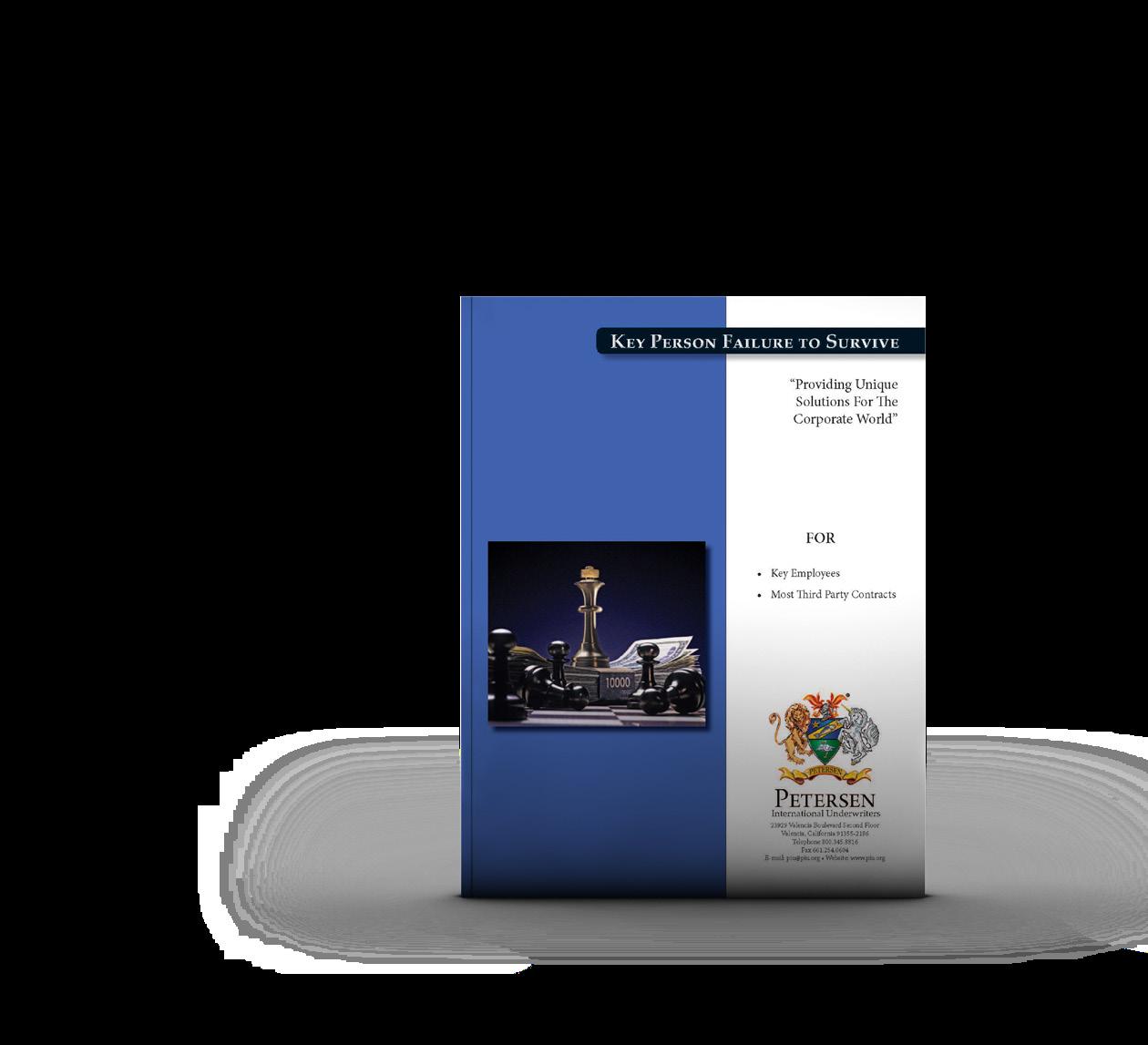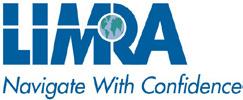A big case doesn’t just fall into your lap. Here are stories of how advisors prepared and worked as a team with other professionals to be ready to win over the big client.

PAGE 12
ALSO INSIDE: A life lesson in success — with John Wheeler
PAGE 6
Amerilife focuses on ‘organic growth’ in next step
PAGE 44

out
THIS MONTH: COUPLES FINANCIAL PLANNING Life • Health/Benefits Annuities • Financial Services FEBRUARY 2023
PLUS: Check
our Couples Financial Planning Thought Leadership Special Section PAGE 17
How top agents and advisors close bigger, better sales by relying on this proven system.







































































The 'easy button' for 10X- ing annuity and life sales...
See why and how this works to predictably increase sales...
Turn to page 4
even 10X production.

Most agents and advisors are bombarded with lead programs, new products, new sales ideas, and the latest tools and tactics — all of which can be good …








But the truth is, the key to doing more business is the ability to close. Consistently.


ONE thing is your “easy button” to help you say and do the right things at the right time, every time, so that prospects are ready to buy.








It helps you efficiently scale your practice, so you can live the life you want to live — without having to do it all yourself.
It helped an advisor who’d never sold an indexed annuity write their first case for $1 million in premium. And helped another advisor gather more than $50 million in new assets in one year. And another to go from $200,000 to $2.7 million in gross revenue.






Turn to page 4, where we’re peeling back the curtain and walking you through what these producers have in common — it’s the easy button for annuity and life sales.
To discover how you could achieve an exponential increase in your annuity and life production this
year, visit BiggerBetterAnnuitySales.com












See what YOU can achieve with a system developed for advisors by an advisor that's helped 3X, 4X and
We’re changing the game
Our winning strategy helps you deliver meaningful results to your clients.


DELIVER MORE with Optavise Now, our powerful communication and scheduling tool.





BOOST PARTICIPATION with in-person or virtual enrollments.




PROVIDE ONGOING ADVOCACY that helps employees make informed healthcare decisions.


OFFER A BROAD PORTFOLIO of voluntary benefits and services your clients need.


209001 © 2022 Optavise We’re changing the game. What’s your next move? Find out how we can help » visit: Optavise.com/INN
www.insurancenewsnet.com/topics/magazine

FEATURE Landing the big case
By Susan Rupe
HEALTH/BENEFITS
36 Most long-term care doesn’t qualify for insurance benefit
By Robert Pokorski
For many clients, death occurs at an earlier stage of disability.


ADVISORNEWS
40 Conventional wisdom and a three-year plan
By Jeff Snyder
INTERVIEW
6 A life lesson in success — with John Wheeler John Wheeler discusses how his early life lessons in a small Illinois town inspired him to help others obtain financial security, which he has been doing for 50 years.
LIFE
27 How to talk to teens and adult children about life insurance
By Diana Angelini
The more advisors encourage clients to talk to their children about financial issues, the less taboo those issues become.
Taxes are going up in the future. Help your clients plan for those tax hikes now.
BUSINESS
42 Will ‘quiet quitting’ cause your clients to quit?
IN THE FIELD
22 A lioness in the industry — with Angie Ribuffo
By John Forcucci
Angie Ribuffo is a champion for women in the industry and for the women she serves.

28 This overlooked asset could help optimize your clients’ financial plan
 By Hector Martinez
By Hector Martinez
How to use life insurance to create tax efficiencies for tomorrow.
ANNUITY

31 The cost of ignoring annuity training compliance
 By Bill Wienhoff
By Bill Wienhoff
By Bhavana Rana
THE KNOW
12 FEBRUARY 2023 » VOLUME 16, NUMBER 02 INSURANCE & FINANCIAL MEDIA NETWORK 150 Corporate Center Drive • Suite 200 • Camp Hill, PA 17011 717.441.9357 www.InsuranceNewsNet.com
44 AmeriLife focuses on ‘organic growth’ in next step

By John Hilton
EDITOR-IN-CHIEF
DATABASE ADMINISTRATOR Sapana Shah
STAFF ACCOUNTANT Katie Turner
John Forcucci MANAGING EDITOR Susan Rupe SENIOR EDITOR John Hilton VP, SALES & MARKETING Susan Chieca CREATIVE DIRECTOR Jacob Haas GRAPHIC DESIGNER Shawn McMillion SENIOR CONTENT STRATEGIST Lori Fogle EMAIL & DIGITAL MARKETING SPECIALIST Megan Kofmehl TRAFFIC COORDINATOR Sorayah Talarek MEDIA OPERATIONS DIRECTOR Ashley McHugh NATIONAL SALES DIRECTOR Sarah Allewelt NATIONAL ACCOUNT DIRECTOR Brian Henderson NATIONAL ACCOUNT DIRECTOR
of, the information published herein. Address Corrections: Update your address at insurancenewsnetmagazine.com
INSURANCE & FINANCIAL MEDIA NE TWORK 6 22 February 2023 » InsuranceNewsNet Magazine 1

Doing your homework on state rules and course choice can prevent problems down the road. View and share the articles from this month’s issue IN THIS ISSUE online » read it
Everyone dreams of winning over the reluctant client or landing the big case. But it doesn’t happen overnight.
PUBLISHER Paul Feldman
Dominic Colardo
Copyright 2023 Insurance & Financial Media Network. All rights reserved. Reproduction or use without permission of editorial or graphic content in any manner is strictly prohibited. How to Reach Us: You may e-mail editor@insurancenewsnet.com, send your letter to 150 Corporate Center Drive, Suite 200, Camp Hill, PA 17011, fax 866.381.8630 or call 717.441.9357. Reprints: Copyright permission can be obtained through InsuranceNewsNet at 717.441.9357, Ext. 125, or reprints@insurancenewsnet.com. Editorial Inquiries: You may e-mail editor@insurancenewsnet.com or call 717.441.9357, ext. 117. Advertising Inquiries: To access InsuranceNewsNet Magazine’s online media kit, go to www.innmediakit.comor call 717.441.9357, Ext. 125, for a sales representative. Postmaster: Send address changes to InsuranceNewsNet Magazine, 150 Corporate Center Drive, Suite 200, Camp Hill, PA 17011. Please allow four weeks for completion of changes. Legal Disclaimer: This publication contains general financial information. It should not be relied upon as a substitute for professional financial or legal advice. We make every effort to offer accurate information, but errors may occur due to the nature of the subject matter and our interpretation of any laws and regulations involved. We provide this information as is, without warranties of any kind, either express or implied. InsuranceNewsNet shall not be liable regardless of the cause or duration for any errors, inaccuracies, omissions or other defects in, or untimeliness or inauthenticity
Staffers who are unhappy in their jobs will have a negative impact on the client experience. IN
This high-growth marketing company sees opportunity in the annuity space.
Out like a lion?

As we near the end of winter, the question inevi tably arises as to whether we’ll get a smooth en try into spring or if winter will go out like a lion, battering us with harsh conditions. For those who are among the 10,000 baby boomers retiring ev ery day in the U.S., the conditions under which they are exiting their working years and entering the retirement phase definitely fall into the “going out like a lion” category, as they face daunting economic conditions.
A combination of factors creating those adverse conditions includes rampant inflation, an unsteady market with forecasts of recession and fear of outliving retirement savings as life spans in crease. For women, the situation is more extreme. They, on aver age, have longer lifespans than men. This means that wives often outlive their husbands. When retirement resources become an issue, therefore, women are most likely to experience shortfalls that could impact their quality of life.
According to a number of studies, women also feel less confi dent in their financial preparedness and understanding, and so are at an additional disadvantage compared to men. To compli cate matters, women born in the older generations often took a back seat in financial decisions, and this left them with less knowledge about financial matters and their individual financial situations.
Changing this dynamic is difficult for a couple of reasons. First, the percentage of female financial advisors is far smaller than their male counterparts. And while there are a number of female advisors serving as mentors and role models for women new to the industry, these efforts have yet to make a large impact on the gender disparity in the workforce. This is an area where more needs to be done. Bringing more women into the industry will almost certainly mean bringing more female clients in as well.
Second, women most often head single-parent households, adding financial strain for those in that situation and making them less attractive clients for advisors who are seeking high-income clients.
These factors mean that more financial advisors should make a special effort to reach out to the women who could most use their services. Providing needed education — and confidence — will serve these clients in good stead, especially as they are more likely to become the surviving partner in the marriage.
Studies have shown that the youngest generations — especially Generation Z — are cognizant of retirement planning. In addition, many in those youngest generations hope to retire at a younger age than previous generations, with age 59 as a popular target age to exit the workforce.
This interest in financial planning provides a strong potential entry point for advisors to connect with younger female clients who are motivated to start saving — and who have the advantage of time on their side. While many younger clients may not currently have the high income that makes them the ideal client, a good number will develop careers that bring higher income into the picture later on. Providing the basic support and education
Helping women prepare for, and feel more confident in, their retirement planning is a service that will benefit both the new clients it will bring into the industry and their advisors.
Out like a lamb
While the economic forces are not at their most ideal for current and soon-to-be retirees, more advisors are bringing sophisticated strategies to bear to help the transition into retirement be more of the “out like a lamb” variety.
Annuities have made a big comeback, due to higher interest rates as well as the need for predictable retirement income in an unpredictable economic environment. The variety of products provide a wide set of offerings that meet most financial situations. Indexed products are also growing rapidly in number, with all manner of indexes being devised and providing many options for advisors and clients.
And while life insurance sales, which spiked during the pandemic, have receded somewhat, using life insurance more strategically to help ensure a segment of retirement income that is impervious to economic conditions is something we’re hearing from more advisors now.
As these strategies and others grow to help build resources — and the confidence — of those planning retirement, we’ll be reaching out to learn more about what products and strategies advisors are finding most successful in this changing economic landscape.
If you’d like to share some of your strategies with our readers, please reach out: editor@innemail.com.
John Forcucci Editor-in-chief
2 InsuranceNewsNet Magazine » February 2023 WELCOME LETTER FROM THE EDITOR
Guaranteed Cash-Out Rider


Three opportunities to fully surrender the policy and receive a partial or full return of premiums paid.1
Guaranteed Death Benefits


Between ages 95 and 121 to ensure your client does not outlive their policy.


Accelerated Benefit Riders
Should your client become seriously ill, a full or partial accelerated death benefit may be available.2

1) Cash-Out Rider may not be available on all substandard rated policies and some may only qualify for the Cash-Out option in the 15th Policy anniversary. 2) The riders are offered at no additional premium. However, the accelerated payment will be less than the requested death benefit because it will be reduced by an actuarial discount and an administrative fee of up to $500. The amount of the actuarial discount is primarily dependent on American National’s determination of the insured’s life expectancy at the time of election. A request for an accelerated benefit may only be advisable if the qualifying event results in a significant reduction in the insured’s life expectancy. A shorter life expectancy will result in a larger benefit offer. Outstanding policy loans will reduce the amount of the benefit payment. SGUL18; GCOR15; ABR14-TM; ABR14-CH; ABR14-CT ND & SD Form Series ABR22-CT, ABR22-CH and ABR22-TM (Forms may vary by state). The contract and riders may not be available in all states. See Policy for details and limitations. American National Insurance Company, Galveston, Texas.

Put your clients in charge now. Call 1-888-501-4043 today or visit img.anicoweb.com for more information or to run a quote.
SIGNATURE GUARANTEED UNIVERSAL LIFE
THE GIFT OF A GUARANTEE
UL puts your client in charge of
policy with flexible guaranteed death benefits, guaranteed access to cash and competitive premiums. For Agent Use Only; Not for Distribution or Use with Consumers. AMERICAN NATIONAL INSURANCE COMPANY 888-501-4043 | img.anicoweb.com IMG23026 | INN 02.2023
Signature Guaranteed
their
Could this be the 'easy button' for 10X- ing your life and annuity sales?

Ifyou’re a successful insurance or financial advisor, you know that closing the sale is dependent on everything you do leading up to getting a signature on the dotted line.
Most importantly, your clients must see you as an expert they trust rather than simply as a salesperson.
To do that, you have to diagnose their problems.
And reveal a need in their current financial situation.
You also know you need to take complex concepts and make them simple.
But what many agents and advisors don’t know is that producers have been using a proprietary system for almost 20 years that makes all of this easy to accomplish — and empowers them to close more business.
In fact, one agent went from $2 million to $12 million in production by using this system.
Multimillion-dollar producers use it to train subagents and scale their practices more efficiently.
And now this system is available to you. Create a sales presentation in just 15 minutes that takes away the fear of the unknown for the client, builds relationships with them and boosts your confidence in closing sales.
Demonstrate your expertise to prospects and clients so that it naturally leads to more life and annuity business. Show clients how surprisingly little market risk they need to take to achieve their retirement goals and dreams — by allocating more to principal-protected financial vehicles.
In the first month using [this sales software], we exceeded our total sales of the last 6 months from the previous year. I can recommend [this system] to any advisor looking to get more production from each prospect or client visit. —Dan R., VA
In this article, we’ll explain how you can get access. But first, why do some financial professionals struggle to increase their annuity and life insurance production?
SOLVE THE REAL PROBLEM
A major reason agents and advisors miss out on life insurance and annuity sales they could be making is because they hav en’t solved the real problem.
You need a consistent way to set up the sale that establishes credibility, evokes emotion, shows you’ve been listening and gives clients greater clarity about their financial future.
If you can check all these boxes, it doesn’t matter if you’re an insurance agent, a financial advisor, completely new or a seasoned veteran — you can make bigger and better sales.
One advisor went from never having sold an indexed annuity to closing their first case for $1 million in premium.
GET THE ULTIMATE ADVISOR ADVANTAGE
What the typical advisor is lacking — that’s helped savvy advisors 3X, 4X, even 10X their production — is the ultimate advantage, because it walks you through what to say and do (and when) during an appointment.
And yes, the strategies will change from client to client. The desired income will be different, their life situations will vary, but what you do should remain the same. Just follow the same simple steps to make more sales.
If you want to streamline your practice and save time — especially if you plan to scale — you need a proven process to grow the business without always having to be working in the business.
If you’re relying on a sales script that only exists in your head and that changes every time you speak to someone, it’s nearly impossible to scale.
With this system, you can simply give subagents a login and they will have the
few million in FIA premium to $20 million in one year — and that equated to his annual gross revenue increasing from $200,000 to $2.7 million. Even he didn’t realize how powerful this would be in client meetings.
Because this system was developed by an advisor for advisors and agents, it’s intuitive. Just enter information from the fact-finder and a comprehensive financial plan will be produced that accounts for the client’s retirement needs, what Social Security will provide them, the income gap they need to solve for and how they can reposition assets to accomplish their goals.
TAKE AWAY THE FEAR OF THE UNKNOWN
One of the most important steps to closing an annuity sale is identifying the amount of assets the prospective client has at risk.
The fact is, no one knows what the markets will do or when the market will bounce back, especially now.
How much of a surprise is it when they look at their investment balances?
If their retirement is based on hope and surprise, they’re likely taking on more risk than they want or need to.
But when they know they only need “X” rate of return, why wait to see what the market’s going to do? Why take on risk that could delay their retirement date?
These are the kinds of conversations you should be having with prospective clients,
which often lead to an annuity purchase — and the potential for 200%-300% more in assets under management.
I had one prospect go to my dinner event and thought he would want to invest $300,000 in an annuity. When he came back, I decided to try out the … presentation. He immediately decided to do $550,000 after seeing [the output]. He sent me a referral who came in thinking about $100,000. After presenting [the system], this prospect decided instead to do $850,000 into an annuity. Finally, I had a third prospect intending to invest $20,000 to “put his foot in the water,” [who] after [this system] changed his investment to $750,000. $2.1 million of annuities … not bad for my first week with [this system]! —Lawrence
BUILD RELATIONSHIPS
The road map you’ll generate lets clients see how they are going to go from where they are now to where they want to be in retirement — and beyond — with an emphasis on retirement income, taxes and investments (in that order). Additionally, with this system, you have a shared language or terminology.
Presenting information in this way creates a positive impression that can open the door to gathering more assets and referrals.
everyone involved.
[This system] has been the shining light when it comes to having my clients understand their files and, in turn, ensure that I close many, many more deals. I am able to close higher amounts in one appointment, saving me time and [providing] clarity to my clients… —Matt
D., NJ
DECREASE SKEPTICISM
O., LA
As you know, building relationships is also key to closing business. While remembering birthdays and providing great service improve the client experience, it’s crucial to inspire trust to build stronger relationships.
When you share concerns and challenges you believe the client may face down the road, clients trust that you have their best interests at heart. That trust deepens the relationships you have with them.
With an easy-to-understand output, clients can clearly see what it means to have a diversified portfolio and, importantly, that they may need more guaranteed products like an annuity or life insurance to truly be diversified.
[This system] has allowed me to tackle much bigger clients than I ever felt possible, and even more clients from $200k-$2m, and they all seem to get it. The [system] is easy to understand and helps make the sale because they can understand the sale much better. This in turn helps my bottom line of production. —Mark
K., GA
ENSURE REGULATORY COMPLIANCE WITH EACH CLIENT
Part of your job as an agent or advisor is making sure you stay compliant with the ever-changing rules and regulations that govern our industry. And that’s not an easy job. However, when you have this easy button, you’re more confident the proper steps are being taken every time with every client.

This leads to “better” sales because they are compliant and well documented for both you and your clients. You have a record of what was discussed and why you made the recommendations you did. It’s a greater measure of protection for
DON'T MISS OUT!
Most clients want to know the recommendations you’re making are sound. In other words, what are your recommendations based on? If you don’t have an answer for that, it can be difficult to get the sale. On the other hand, when you can provide your clients with documentation to support your recommendations, you establish credibility.
The short four-page document you receive as an output of this system details everything you’ve shared with the client. What’s even more important is it shows clients your recommendations don’t originate with a product you want to sell them.

Instead, you can show a client the rate of return they need each year to have enough income to sustain their lifestyle in retirement. Then the question becomes “How do I achieve that?”
Now they are open to a discussion about the products you can offer because you’ve pre-framed them with everything leading up to this point.
So, are you ready to have conversations with prospects and clients that naturally lead to sales of life and annuities?
You've just found what may be your easy button for 10X-ing your life and annuity sales. Visit BiggerBetterAnnuitySales.com today to find out more, including how you can get exclusive access.
A LIFE LESSON IN SUCCESS
Growing up poor, JOHN WHEELER got into the insurance business to make a better life for himself. When he realized that he could improve the lives of others, he says, the business “got into me.” Fifty years later, he’s still going strong as a financial advisor helping others.
An interview with Paul Feldman, publisher

6 InsuranceNewsNet Magazine » February 2023 INTERVIEW
John Wheeler, senior executive partner of Totus Insurance Agency LLC has an extensive background in the financial services industry that began in 1969. Growing up in a small town, where life insurance could mean the difference between a family keeping and losing their home, he quickly learned that having tough conversations with friends and acquaintances could change their future as well as create a path to success for him.
Those early lessons quickly taught him the important role a financial advisor can play in the lives of others. He’s worked to continuously educate himself about the business and share what he knows with others. A lifelong learner, Wheeler is one of only three people in the U.S. who has taught the entire CFP certification program, which he began teaching in 1985.
He’s served as an NAIFA national trustee and past president of NAIFA Illinois, has served two terms as president of NAIFA Chicagoland, will be serving on the NAIFA Texas Board beginning in January 2023, and is currently president of Forum 400, an exclusive community that brings together elite insurance producers to openly share practical strategies and fresh ideas. A frequent conference speaker, he has taught at DePaul University’s School of Continuing and Professional Studies and has been a frequent lecturer for The Insurance Sales Institute at Purdue University.
Having grown up in a small town in Illinois, Wheeler decided he wanted to go into the insurance business when he discovered that the most successful-looking man in the county seat sold insurance. Well, I guess that’s as good as anything, he thought. He’s never looked back.
Paul Feldman: You grew up in a small town in Illinois. How did you get into the insurance business?
John Wheeler: I grew up in a town of 54 people, a county population of 8,000 — so it wasn’t a booming metropolis by a long shot. My father worked in the oil field. He made $10,500 in 1972, the last year of his life, when he was killed on the job in an explosion. That’s the most money he’d ever made. From the time I was 13 years old, I pretty well bought my own
clothes, provided for myself, did every odd job that I could.
We grew up what most people would consider poor. We didn’t necessarily know we were poor. There were a lot of families around me that had more than we had, but we still had our pride. We never received assistance of any type. We just worked. My father taught me a good work ethic.
There was a guy in McLeansboro — the county seat of Hamilton County — which had 2,600 people. He always drove a nice car and dressed nice, and everybody liked him. I asked, “What’s he do?” “Well, he’s in the insurance business,” I was told. I said, “Well, I guess that’s as good as anything.”
So, on my 18th birthday — which was the soonest I could do it — I drove 3 1/2 hours to Springfield, the state capital. I took the insurance exam, which, at that
my shoulder and I’m crying on her shoulder. She said, “I wish Jeff had a chance to talk to you about life insurance. He knew we probably needed to buy it, and he wouldn’t have bought it from anybody but you. But he said, ‘John’s new in the business. When he gets settled down, I’m sure he’ll talk to us.’” Well, we never did talk. She and the two kids lost their home, had to move back in with her parents.
It was my fault because I didn’t want to impose on friends and family when, in fact, my friend was relying on me and I didn’t know it. I think that’s one mistake a lot of people make when they first start in the business. Well, after that happened with Jeff, I even had the courage to approach an old girlfriend’s parents. Now, in a small town, that’s real courage. The fellow was 58 years old, and he had never bought life insurance. Didn’t believe in
time, was a legal-page-sized essay question test. All of a sudden, I’m in the insurance business.
I had a good friend who had returned from serving in the Navy and had gone to work with a major carrier. The major carrier promoted him into management. After a year, he recruited me, and that’s where my career started.
That’s how I got into the business. What I think is more important, though, is when the business got into me.
I got into the business because I knew I wanted something better out of life. When I started out, I had promised myself that if I was going to make it in the business, I wouldn’t impose on my friends and family. I was going to make it on my own. About six months after I went to work for the major carrier, a good friend of mine was killed in a car accident.
Well, at the wake, his wife is crying on
it. I went to see him and he said, “Look, I know you’re in the insurance business.” Because in small towns, there are no secrets. He said, “I don’t believe in it. I don’t want to talk to you.” I told him about my experience with Jeff and what that had made me feel like.
I said, “I care about you and your family. I never want to feel like that again. All I ask is you give me 30 minutes to have a conversation. If at that point you still don’t want to do anything, the monkey’s off my back.” After about 45 minutes, he bought a $250,000 whole life policy with a waiver premium. In 1969, that was a pretty big sale. That was great from a financial standpoint, and I felt, OK, I provided a service.
Well, six months later, he’s out on the tractor one day and he has a heart attack, but he didn’t die. That gave me the chance to see how a waiver premium worked. He
February 2023 » InsuranceNewsNet Magazine 7 A LIFE LESSON IN SUCCESS — WITH JOHN WHEELER INTERVIEW
At the wake, Ruby, his wife, was crying on my shoulder. She said, “If it hadn’t been for you, we’d have lost the farm.”
was eventually able to get back to work. About two years later, he ended up having another heart attack. This time, he wasn’t as fortunate. At the wake, Ruby, his wife, was crying on my shoulder. I’m crying on her shoulder. She said, “If it hadn’t been for you, we’d have lost the farm.”
That’s when the business got into me. When I found my purpose, that’s when things got meaningful.
Feldman: That’s a powerful story. You’re a constant learner and also a constant teacher. You’ve taught the CFP program and you’re one of three teachers in the country who has taught the entire program, correct?
Wheeler: Yes, that’s what I’ve been told. I’m one of three people in the U.S. crazy enough to teach the entire program. And that was baptism by fire. Because when you’re standing in front of a group of other people from a very diverse background — I mean, I’d have CPAs, attorneys, trust officers, real estate people, insurance people, securities people, people trying to change careers — you have to learn how to explain things in different ways so that they are able to internalize the information.
The CFP education is not just a matter of memorization and regurgitating that information. It’s a matter of application. I think most people would say that it’s one of the more grueling exams there is. I’ve even had attorneys and CPAs say it was the worst exam they ever took.
When you get to the point when you think you know it all, that’s when you’re in trouble because life is continually changing. The industry continues to change. As the old adage goes: Even if you’re on the right track, if you just stand there you’ll get run over. The same thing applies to learning.
When I started in the business, I didn’t know anything. So I decided, “OK, I’m going to commit an hour to an hour and a half per day to improving my knowledge and my skills.” I’ve done that for 53 years. Learning is a continual process. I can’t stress that enough.
Feldman: You work primarily with high-wealth clients. What are the major differences between high-wealth and other clients?
Wheeler: The only difference, in my opinion, between a high net worth client and someone who barely has two nickels to rub together is that the problems of high net worth individuals are magnified. Whether we’re dealing with high net worth individuals or anybody else, I start based on three questions. First, what’s important to you? What are your goals and your desires, your dreams? Tell me what really matters to you. I’ll drill down as deep as you will go, continuing to ask questions to get a depth of understanding about what makes you tick and what’s important to you.

Second, I’ll ask you what are the things that could jeopardize reaching those goals and objectives? Now, I know the answer to that. But if you tell me, that’s altogether different from me telling you. God gave us two eyes, two ears and one mouth, and when we’re dealing with clients or prospects, we ought to use them in that proportion. Let’s say you can’t work for a period of time, for example. Or you’re on the wrong side of a lawsuit. You get divorced. You’ve lost your job. If I ask more questions and make fewer statements, we’ll typically have better communication.
The third question I ask — when it’s appropriate, and most of the time it is in one way or another — is how do you want to be remembered? If it’s a family situation, do you want to be remembered as a
mother or father who loved your family so much that you wanted to be sure they’re taken care of? Or do you want to be the mother or father who had good intentions but never got around to taking care of business?
Or if you’re a business owner and you told me that you want your business to continue and to be passed on, do you want to be known as that business owner who made sure everything was in sync for the continuation of that business or for the value to be preserved for the family? Or do you want to be the business owner who just never quite got around to taking care of your legacy?
Any conversation, whether it’s with someone who has a $10,000 net worth or $100 million net worth, is around those three questions.
Feldman: What is a piece of advice you offer through your courses that your students find most interesting or shocking? A real lightbulb-changer for them?
Wheeler: The better I can get to know a client and their situation, the more I’m there for them. I want people to feel comfortable about their retirement. Well, what is going to make them feel comfortable? Some people, if they didn’t have $50,000 a week, would feel like they’re
8 InsuranceNewsNet Magazine » February 2023 INTERVIEW A LIFE LESSON IN SUCCESS — WITH JOHN WHEELER
When you get to the point when you think you know it all, that’s when you’re in trouble because life is continually changing. As the old adage goes: Even if you’re on the right track, if you just stand there you’ll get run over.
doing without. Others, if they had $50,000 a year, they’d think they’re all set. Again, it’s a matter of understanding perspective.
Not everybody can get on a roller coaster after eating tacos and have the same experience. Sometimes they don’t have the stomach for the ride. It’s all about the questions we ask and how we really get into what’s important. I don’t consider myself a salesperson. I just help people make educated decisions.
I tell clients every day, “Look, I don’t have to live with the results of your decisions — you do.” They have to be committed to those results because they have to live with them.
Feldman: Given the way this economy’s been going, how have your recommendations changed over the past couple of years?
Wheeler: Well, I think the key thing is you have to have a process. A process may be adjusted, but it doesn’t really change. Again, I go back to my three questions. Now, the solutions may vary to some degree. I may have champagne taste and a beer pocketbook.
The key thing is doing something to either work toward or help you achieve what’s important. I haven’t seen that change in 53 years. There are a lot more products and services available today than there were 53 years ago. When I started, you had a rate book that you could put in your pocket because there weren’t many products. Today there’s a litany of products, and the biggest challenge sometimes is confusion because of that — because you have apples and oranges … and watermelons.
If you look at term insurance, it’s great as long as you die on time. All term insurance is actuarially priced to lapse before you die. Again, can it be a BandAid? Absolutely. Because here again, you want to be sure that there’s enough death benefit in place to take care of what’s imperative today. But it isn’t going to be a long-term solution.
A lot of people say, “Well, when I build enough wealth, I no longer need insurance.” My response to that would be: At what point are you wealthy enough that you would intentionally overpay for anything? Did you see yourself walking up to the Mercedes dealer and saying, “I want
to pay full sticker plus 40% just because I can.”? They laugh and say, “Well, no.” I’ll say, “Well, that’s what you’re telling me.”
The high net worth individual’s biggest problem normally is liquidity. If you have to sell something at the wrong time, that can be catastrophic. We know the market goes up and the market goes down. We know interest rates go up and interest rates go down. If you want surety and certainty, that’s where proper planning comes in.
The biggest challenge in retirement is health. We talk about how long-term care, if needed in retirement, can be more catastrophic than any market volatility we’ve ever seen. People don’t worry about that as much when they’re young as they do when they get closer to retirement. When they’re younger, it’s usually more about providing replacement of income for my family if something happens to me, perhaps, or to cover debts. Hopefully by the time we get closer to retirement, covering debts isn’t as big an issue and I’ve got assets to provide. But at that point, I have to be able to preserve them.
We talk about accumulation of assets, preservation of assets and then finally distribution of assets. That’s when we get into the more advanced tax issues. If I know what matters to you and what’s important to you, then we can have those follow-up conversations to get to that point. As the great philosopher Yogi Berra said, “If you don’t know where you’re going, how can you be sure you’re not already there?”
Feldman: Is life insurance playing a more prominent role in retirement strategies given the current economic circumstances?
Wheeler: Yes, in many situations. When you get into tax issues, properly structured permanent insurance can provide a volatility buffer or can provide tax-free income. The only other thing that truly is tax-free is Roth, but there’s a limitation on how much you can put in Roth. The more tax-free income you can have, the more flexibility you have from a planning perspective. Life insurance can provide that. By the same token, life insurance can replace part of what I spent while I was alive in my retirement years, so that helps provide a legacy or security for my surviving family.
Feldman: How about annuities? Is this a good time to buy annuities, with interest rates going up?
Wheeler: An annuity, used properly, can do something nothing else can: provide an income that you can’t outlive. If you’re talking about having it for income purposes, an annuity, in my opinion, should be a part of the planning process because it provides a base. An annuity, when you think about it, is not a lot different from a pension. Fewer and fewer people today have pensions.
In the pre-retirement years, it can be something to look at, certainly. For a younger individual, I would want an annuity that perhaps would change either with some type of cost-of-living adjustment or some type of potential growth. What are you trying to achieve? It’s another tool in the toolbox.
Feldman: Any final thoughts that you want to impart to our readers?
Wheeler: First, it’s important to get involved in your community. I was one of the founders of DuPage County’s Habitat for Humanity because I believed in helping people help themselves. I was one of the founders of the Carol Stream Chamber of Commerce. People will get to know you, and they get to know that they can trust you and that your word is good. My father said, “Your word is your bond, and there’s never a right way to do a wrong thing.”
Second, you have to continue to hone your craft. You always have to be trying to improve. The definition of luck is when preparation meets opportunity. If you put in the time, you’ll always be prepared.
Finally, I think you have to decide whether this is just a job or a career. If it’s a job, you’re looking at it purely as a paycheck. If it’s a career, you’re looking at it with more of a purpose.
I think, overall, our industry provides one of the greatest services to humanity that there is, outside of possibly medicine or the clergy. Because when I go to a wake, I’m carrying a check while everybody else is giving sympathy and prayers. I’ve never known a widow or a widower yet who sent back money to the insurance company because they got too much.
A LIFE LESSON IN SUCCESS — WITH JOHN WHEELER INTERVIEW February 2023 » InsuranceNewsNet Magazine 9
Americans’ worries shift from COVID-19 to inflation
With the COVID-19 vaccination rate up and the number of deaths significantly declining, only 1 in 5 adults are “very” or “extremely” concerned about the virus today, according to LIMRA. LIMRA’s research found more than 3 in 5 adults said their lives are largely back to what they were like before the pandemic.
While less concerned about the pandemic, 56% of adults are “very” or “extremely” concerned about the economy.
More than 8 in 10 consumers acknowledge one or more changes in their behavior. For nearly all, the changes include “favorable actions” or steps that are likely to improve their financial stability and security. Most often, this involves changes to their spending and becoming more budget conscious; although some consumers have also been able to put more money into a savings account, invest more, and/or increase contributions to a retirement plan.
Over half of consumers, however, have taken “unfavorable actions,” such as saving or investing less, increasing one’s debt, cutting back on retirement contributions, or skipping medical care.
AIG SUBSIDIARY FILES BANKRUPTCY AMID ONGOING SUIT
An AIG subsidiary filed for Chapter 11 bankruptcy, a move panned by a group of former executives suing the insurer.

AIG Financial Products Corp. made the filing in the U.S. Bankruptcy Court for the District of Delaware and plans to reorganize. AIG said in a regulatory filing that the reorganization won’t have a material impact on its consolidated balance sheets or those of Corebridge Financial (formerly AIG Life & Retirement).
AIG Financial Products has no material operations or businesses and no employees.
Meanwhile, a group of former executives say the timing of the bankruptcy filing is designed to avoid legal obligations. “The real impetus for AIGFPC’s bankruptcy filing is to avoid repaying certain deferred compensation it owes to the Employee Plaintiffs, 46 former employees from whom AIGFP borrowed approximately $194 million during the 2008 financial crisis but has never repaid,” the plaintiffs said in a court filing.


QUOTABLE
independent contractors or working with them. Financial and insurance industry advocates are concerned that individual agents and brokers are subject to a patchwork of state and federal regulations under changes favored by the Democrats.

MORE PEOPLE HAVE SIDE GIGS TO COPE WITH INFLATION
DOL RECEIVES NEARLY 50K COMMENTS ON INDEPENDENT CONTRACTOR RULE
The U.S. Chamber of Commerce is calling on the Department of Labor to scrap its independent contractor rule.
The DOL independent contractor proposal would make it harder for companies to treat workers as independent contractors, potentially upending several industries, including financial services. Controversy continues to follow the rule proposals, which affect various industries in different ways.
The DOL initially planned to close a comment period in November but tacked on an extra 15 days, extending the deadline to Dec. 13. According to the website, the department received 49,734 comments on the proposed rule.
Many of the thousands of comments came from independent real estate agents, financial professionals and others who wrote of their experiences being
If it seems as though more people are working a side hustle in addition to their regular 9-to-5, you’re right. More than 4 out of 5 Americans who have or plan to take on a side gig, seasonal job or extra hours at work say inflation played a role in their decision. In November, Bureau of Labor Statistics reported a 165,000 jump in the number of people holding multiple jobs. That was the largest rise since June.
Most adults (68%) either already have or plan to pick up a side gig — like delivering food with DoorDash or renting out extra space in their homes — according to a Neighbor.com survey. Additionally, 44% of Americans work or plan to work a seasonal job, like shipping packages for Amazon or stocking and unloading for Walmart. And 51% either work or plan to work overtime at their current 9-to-5 job, the survey said.
Of those taking on extra jobs, 18-to40-year-olds remain the largest group of side hustlers, said Kathy Kristof, editor at SideHusl, which researches opportunities to make extra money. “But over the past six months, we’ve seen an increasing number of seniors looking to help make ends meet,” she said.

10 InsuranceNewsNet Magazine » February 2023 WIRES
DID YOU KNOW ? Source: The Wall Street Journal
Everybody’s five times better off than they used to be.
—
Charlie Munger,
longtime investment partner and friend of Warren Buffett
U.S. government pension funds currently have the lowest cash holdings since the 2008 financial crisis.
• Marc Cadin, Finseca CEO


View all our past recordings and sign up for upcoming webinars at innwebinars.com. InsuranceNewsNet’s Webinar Series Monthly Conversations with Industry Leaders Join InsuranceNewsNet’s award-winning editorial staff as we host in-depth discussions with industry movers and shakers. These free, live webinars will explore the latest trends and research in the annuity, life, health and financial industries. Join us live for your chance to ask questions directly, or if you can’t make it, view recordings of each in our free on-demand library. Hear from experts in your field like...
President
CEO
Intelligence
• Sheryl Moore,
and
of Moore Market
President
• Diane Boyle, Senior Vice
of Government Relations at NAIFA
• Jamie Hopkins • David Levenson, LL Global CEO
A big case doesn’t just fall into your lap. Here are stories of how advisors prepared and worked as a team with other professionals to be ready to win over the big client.

 By Susan Rupe
By Susan Rupe

12 InsuranceNewsNet Magazine » February 2023
We all dream of landing the big case or winning over the elusive client.
But that kind of success doesn’t just happen.
It takes preparation, patience and networking. While being in the right place at the right time can be a factor in winning the big case, having the right kind of expertise to give that big client what they need most can make the difference.
Three advisors share their “big case stories” with InsuranceNewsNet and provide their insights on how to win a big case of your own.
‘No does not mean never’


Sometimes it can take years for a seed to sprout and grow into a big case.
Jeff Chernoff met an attorney in his community through a business club they both belonged to. When they followed up over a cup of coffee, the attorney mentioned
But even though the key-person insurance discussion stopped, Chernoff’s business relationship with the attorney continued. Three years later, he brought up the topic of insurance again.
“I had a conversation with them, and I asked them, ‘Is this something that interests you?’ At that point in time, her husband had transitioned out of the financial services industry and had moved into becoming the chief financial officer of that small law firm. And she said, ‘You know, it does kind of interest me. Let’s talk about it.’”
Chernoff said he explained the benefits of key person insurance using a cash value policy. “I explained how this can be a benefit and how you can supplement retirement savings if it’s done correctly,” he said.


His client decided to take out a policy on her top-producing attorney. It was the largest life insurance case Chernoff had written after being in the business for six years.
Chernoff said his ability to continue the relationship with his client even after being told “no” was a big factor in his landing the sale.
“We continued the relationship, we were never deterred about being told ‘no,’” he said. “I was comfortable with being told ‘no’ and not upset about it and then when the time was right, asking the question again in as gentle a way as possible.”
Chernoff said he learned several lessons from this particular case.
“First of all, ‘no’ does not mean ‘never.’ Second, if you keep a relationship positive, you never know the opportunities you will generate from that. And don’t be shy or don’t be unwilling to simply ask the question — you might get a ‘yes.’”
that her business insurance was up for renewal and asked Chernoff to meet with her and her husband to review her coverage.
The client who gave Chernoff his first big sale ended up giving him another big sale two years later.
At a conference on advanced planning, Chernoff learned how a business owner or a business can have a 401(k) plan with a profit sharing plan. He also learned about a defined benefit plan that can hold cash value life insurance and would be a good fit for attorneys, particularly attorneys who are age 50 or older and plan to work another five to 10 years.
He thought his attorney client would be perfect for this plan. He reached out to the territory manager of the company that offered the plan to learn more, and the
LANDING THE BIG CASE COVER STORY February 2023 » InsuranceNewsNet Magazine 13
Chernoff
broker-dealer. “I found one that works really well with small plans with less than $250,000 in assets, I found another one that is comfortable working with midsize plans of $500,000 above and I found another one that’s comfortable with a $1 million plan.”
With his experts lined up and his information gathered, Chernoff approached his attorney client and asked whether her firm offered 401(k)s.

“They said, ‘No, we talked about it a few years ago, but it didn’t make sense for us at that time.’ So I broke it down in terms of how they can maximize saving for retirement. They were interested in learning more, so we sat down with the third-party administrator, we went over everything and they agreed to sign the deal.”
The law firm put about $30,000 into the plan the first year, Chernoff said. From there, the firm’s contributions increased to $125,000 annually and then to $300,000. “It just kept building and building,” he said. “And I believe I’ll be in the business long enough to keep creating this long-term relationship.”
two children. A few years after buying the policy, the client reviewed the coverage with Chernoff and told him he was bringing in a new business partner and was interested in life insurance to fund a buy-sell agreement with the new partner and his existing partners.
After putting that plan in place, the client asked Chernoff to assist his wife in creating an individual retirement account, as she planned to invest funds accumulated during her career in education.
“All because my client wanted life insurance for his two kids,” Chernoff said.
“Three years ago, he said to me, anytime I have an insurance thing or investment thing, I’m coming to you first because clearly you take care of me and you take care of my family.”
‘You have to know your stuff’

Sometimes it takes a village to help land a big client. And the successful advisor will be the one who can work with that client’s “village” of other professional advisors.
Eryka Morehead is president of Collaborative Planning Group in

who need help with estate planning and business succession planning.
To land a big case with this particular market, “You have to know your stuff, technically,” she said.
“Our firm has had a lot of success working with those types of individuals, because we have a lot of technical knowledge on the estate planning, business succession planning side. And so we can kind of help facilitate and work hand in hand with their other professional advisors.
“When you know your stuff, you can well represent yourself in the room with the client’s accountant, with their attorney, with their financial advisor,” she said. “All clients have their team. I think that in our industry, especially on the life insurance side, people will work to place a policy or have siloed conversations with the client regarding the life insurance.
“When you don’t have all the client’s professional advisors on board, all working off the same blueprint for the client’s overall planning goals, it makes it much harder to help the client implement life insurance for a funding strategy or as a protection solution if the rest of the team of advisors isn’t on the same page.”

14 InsuranceNewsNet Magazine » February 2023
“... if you keep a relationship positive, you never know the opportunities you will generate from that. And don’t be shy or don’t be unwilling to simply ask the question — you might get a ‘yes.’” — Jeff Chernoff
Morehead
Being successful in landing the big client is about more than simply knowing the product and how it works, Morehead said.
“You also need to understand all the ancillary lines that the product touches,” she said. “For example, with life insurance, you need to understand who the owner will be, who the payer will be, how the beneficiary is going to work. You must make sure you have the technical acumen for all the legal side to be able to participate in the discussions surrounding the structure.
Morehead said she was contacted by an estate attorney who was concerned that their client was being pitched an insur ance product that might not be appropri ate for their needs. She was asked to come in to review the insurance the client had in place at that time.
“Whenever we do a review, we also need to get the client’s tax returns, copies of trusts, financial statements — because in order to review an insurance strategy, you must understand the context of the client’s entire situation,” she said. “After reviewing the strategy and walking through the technical aspect of the product that the client had been presented, we pivoted and went toward a more comprehensive planning approach as opposed to merely suggesting a product.”
Morehead played the part of the coordi nator, getting the other professionals together to help him with his plan.
“Over the last seven years, our relationship has continued to build, continued to develop, and there have been multiple steps along the way where they have needed to purchase more insurance for this or for that — multiple hundreds of thousands of dollars in premium,” she said.
Morehead worked with the owner of a large cattle operation who said he didn’t believe in life insurance. But he also realized he needed to protect his business, so Morehead helped him assemble a team of experts and brought them all to her office. The business owner brought his chief financial officer to the meeting as well.
“That’s how you then build a reputation with the other professionals so they end up loving the work you do for that client. Then they start seeing you as a resource the next time a situation comes up that needs a similar solution.”
Trust is another factor in landing the big client, Morehead said.
“You build trust by your technical knowledge, people need to know that you know your stuff,” she said. “But you also build trust with good and pure intentions. Sometimes we work with clients where we think the case will go one way and it ends up going another way. But at the end of the day, when you’re working with that team of professional advisors, it becomes clear what better options or better choices are available for that client.”
Morehead said she believes “a product without a plan may or may not work. But if you have a plan and then you place the product, you’re specific on what role the product will play. And when the product is properly matched with the client’s plan and goals, it just makes sense.”
At the end of her second meeting with the client and professional team, the client told her, “We feel like we’re not being sold a product. For the first time, we feel like we’re starting to develop a plan.”
The planning paid off when the client agreed to a plan that included twice as much life insurance as what they originally had been pitched.
Several years ago, Morehead worked with two business partners who had an

“We even ended up working one of his oldest children into some of the conversations as well, because there were a lot of moving pieces and parts going on with this organization. But we were able to help get the estate plan and the trust set up. And then we did place a significant amount of life insurance in order to infuse liquidity into the estate.
“And then separately, they worked on some estate freezing techniques with their estate attorney. So it was kind of a blended effort of a gifting strategy and life insurance building some liquidity into their plan.”
Morehead said she is undaunted when she hears a prospect say they don’t believe in life insurance.
“We don’t have to call it life insurance. It’s not a religion. We don’t have to believe in it or not believe in it. It’s a tool, and we


February 2023 » InsuranceNewsNet Magazine 15
“When you know your stuff, you can well represent yourself in the room with the client’s accountant, with their attorney, with their financial advisor.”
— Eryka Morehead
need to find out if that tool would be helpful for their situation.”
‘It doesn’t come overnight’
“Persistence pays off” is Danny O’Connell’s motto when it comes to landing the big case. O’Connell is CEO of Next Level Insurance Agency in Addison, Texas.

“If somebody goes dark on you and you don’t hear anything, you know people want to do business with someone they know, like and trust. And that doesn’t come overnight. That takes time,” he said.
O’Connell eventually had a meeting with the business owner and told her upfront, “Before we go through this entire process, I just want to be sure that this is even a possibility. I don’t want to waste your time.”
To his surprise, the business owner agreed to continue with the process. As O’Connell and his team began working on a proposal, he learned that a year earlier, the owner had been determined to work with a close friend who was in the employee benefits business. But she decided
renew their business on a three- or fouryear deal and then move on,” he said. “But for our clients, we want to tell the story and we want to paint the picture and we would explain our strategy. Most of our competitors are like, ‘You send us the numbers and we give you a quote.’ But because we were able to tell the story and have a strategy, we got a much better outcome than this other advisor.
“And ultimately, we wound up winning the group and being able to meet their deadlines and save them a boatload of

One of O’Connell’s biggest clients came to him after his firm did some cold calling. It was a large employer, looking to renew their employee benefits contract.
“They didn’t renew until Jan. 1. And I was introduced to them the January right after they went through a renewal process. I knew that I was competing with some other people, much larger firms than we were. So, we took a holistic approach. We brought in all the different components that they may need.”
During the process of bringing the team together, O’Connell said, one of his partners warned him that the owner, a woman, wouldn’t do business with him because she didn’t like doing business with men.
“That was disappointing, but we went through our process,” he said. “We got some options from one of the carriers who I thought would be really competitive. And they weren’t.”
to perform some due diligence and look at other providers.
“We continued to do our work, continued to stay in communication and continued to do our part,” O’Connell said. “And ultimately, we wound up winning the group.
“It was what the executives were looking for. We provided a transparency that they had never been given before. We provided the ability to forecast and work on things and see trends, see numbers and things they never had seen before. We’ve had a great relationship with this group, and we went through their last renewal last year. And they’re pleased because they really got what they were looking for.”
In another case, O’Connell was able to win the benefits business of an 1,800-person company that initially approached him to solve one of the employees’ main sources of pain — a technology platform that didn’t work well. The technology situation eventually was resolved. But O’Connell wasn’t satisfied to stop there.
“The advisor they were working with thought they were automatically going to
money — $240,000 in the first year.”
O’Connell said relieving the frustration of his clients’ employees and giving them more options are some of the keys to keeping clients happy.
“What are the little things that we can do to avoid that frustration? How can we educate people? How can we guide them to get on the right plan so that they have a better experience, less frustration, fewer issues with their employer, fewer customer service issues? In most of life’s situations, you get what you pay for. But you must have somebody who’s willing to educate and go where your client needs you to go, and service their people the way that we all want to be treated.”
Susan Rupe is managing editor for InsuranceNewsNet. She formerly served as communications director for an insurance agents’ association and was an award-winning newspaper reporter and editor. Contact her at Susan.Rupe@innfeedback.com. Follow her on Twitter @INNsusan.

COVER STORY LANDING THE BIG CASE
16 InsuranceNewsNet Magazine » February 2023
“Most of our competitors are like, ‘You send us the numbers and we give you a quote.’ But because we were able to tell the story and have a strategy, we got a much better outcome than this other advisor.”
— Danny O’Connell
O’Connell
THOUGHT LEADERSHIP SERIES
COUPLES NEED FINANCIAL HELP!
In this year’s special Couples Financial Planning Thought Leadership Series, we showcase products and solutions from carriers and financial organizations created with duos in mind.

INSIDE
Life insurance products can ease financial pain points of the middle market. But can you really make a living serving these clients?
by Allianz Life
PAGE 18
How Annuity.org is delivering hot, ready-to-buy annuity leads with Tom Hope, Riley Schott and Emily Powell of Annuty.org PAGE 20
Protective Aspirations variable annuity: the couples’ retirement income solution you’ve been missing with Corinne Anderson of Protective Life
21
PAGE
SPECIAL SPONSORED SECTION
Life insurance can ease financial pain points of the middle market. But can you really make a living serving these clients?
When you’re considering potential clients for life insurance, the middle market may not be your first choice. Certainly, high net worth clients who need tax planning strategies, flexible estate planning strategies and a larger death benefit are a lucrative market.
But you may be missing out on a large pool of potential clients who need life insurance coverage and could benefit from cash value life insurance like fixed index universal life (FIUL) insurance to potentially supplement a retirement planning strategy or college funding.
In a 2022 study, Allianz Life Insurance Company of North America (Allianz Life) took a deep dive into the financial needs and mindsets of middle market consumers. They surveyed 800 individuals, aged 25 to 45, who contribute to a company-sponsored 401(k) and have discretionary income to spend on products that can address common concerns around financial risks.1
Significantly, Allianz found that nearly half have never worked with a financial professional — a huge, often overlooked opportunity for referrals, increased revenue and new life insurance sales.
However, misconceptions about the middle market may be standing in your way. Let’s look at three myths and how they’re challenged by the findings of the 2022 Allianz Middle Market Study.
Middle Market Myth #1: They aren’t interested in life insurance.
The middle market cohort is made of people between 30 and 45 years old who’ve been pursuing their careers for a number of years. They understand the importance of retirement savings and tend to have a 401(k) plan into which they’re contributing up to the company match.
They’re also aware of a variety of financial risks. Concerns about inflation, access to cash in case of an emergency, market volatility and having multiple sources of income in retirement were all top of mind in the survey.
At the same time, respondents often believed cash value life insurance was too expensive or too confusing — pointing to a
29% of females surveyed said they have never used a professional financial advisor but would consider using one.
need for greater education about the ability of FIUL to address many of their financial concerns.
A large majority expressed interest in potentially tax-free sources of income in retirement, increasing the amount of inheritance to family or loved ones, and funds that can be accessed for a special need —all potential benefits of FIUL.
In fact, 84% of men said that the ability to accumulate money on a tax-deferred basis is important to them in retirement; 77% of women agreed this is very or somewhat important to them when it comes to deciding where to put their money.
Life insurance can also ease concerns by providing the potential for supplemental income in retirement (through policy loans and withdrawals from available cash value2) that could help fund their desired lifestyle and help with other costs like health care or vacations.
49% of male respondents worried that if they died today, their spouse/partner wouldn’t be able to save enough for retirement.
Consider Thomas and Mya, a hypothetical (but typical) couple with two incomes and two young children.3 After their mortgage, car payments and household expenses, they have $250 in discretionary income each month. They considered opening a Roth IRA, but their household income exceeds the 2023 limit for contributions. Instead, they decided to put that amount into an asset that can offer them financial protection and accumulate in value over time. Using their financial professional, Thomas and Mya purchased an Allianz Life Pro+® Advantage Fixed Index Universal Life Insurance policy.
Along with the death benefit it provides, Thomas and Mya will have accumulation potential through indexed or fixed interest, protection from loss due to market volatility, and access to any available cash value via income-tax-free loans and withdrawals. 2
Through the power of tax-deferral and compounding, after 20 years of funding their policy with that $250 a month premium, they theoretically have over $80,000 in accumulation value — enough for a down payment on a retirement home in Arizona when they’re 65.
And because their policy will continue to earn interest, by the time they reach 85, they could have over $300K in the death benefit to leave as a legacy. They will want to carefully manage
2023 Couples Financial Planning • Special Sponsored Section 18 InsuranceNewsNet Magazine » February 2023
their policy values when taking policy loans to help prevent a policy lapse and potential tax consequences.
Middle Market Myth #2: They can’t afford permanent life insurance.
With household incomes of $100K+, middle market consumers report having between $150 and $400 available each month to put into a financial product that can help ease financial pain points.
This can be enough to fund a permanent life insurance policy, which will provide financial protection in the event of the death of a partner or spouse — and, depending on the policy type, could be a source of funds in the years to come.
Let’s look at another hypothetical couple, Caitlyn and James, married and both aged 35. 4 They would like to start saving for the future college education of their young son, Liam.
After paying their household bills and contributing to their 401(k)s, they have a few hundred dollars left over each month. Since Caitlyn already has a term policy through her work, they purchase an Allianz Life Pro+® Advantage Fixed Index Universal Life Insurance policy with James as the insured, since they rely on his salary for most of their household income.
Permanent life insurance will give them the long-term reassurance of a death benefit that is generally paid to beneficiaries income tax-free. But just as important, the cash value is a potential resource that could be accessed via income-tax-free policy loans and withdrawals 2 to help supplement Liam’s college education.
Assuming Caitlyn and James make $300 monthly premium payments, after 20 years, they could access $15,000 per year via policy loans to supplement college expenses — and still have a death benefit of more than $280,000 by the time they reach 85. They will want to carefully manage their policy values when taking policy loans to help prevent a policy lapse and potential tax consequences.
And unlike a 529 plan, if Liam opts not to go to college, the cash value in the policy could be used however they see fit.
Middle Market Myth #3: Financial professionals lose money pursuing these clients.
Admittedly, a few hundred a month may not sound like much premium to fund a permanent life insurance policy. And when you consider the amount of time it can take to acquire and provide services to a client, it may not immediately make economic sense.
However, if you take a long-term view, middle market clients can be well worth the time and effort you invest in them.
According to the 2022 Insurance Barometer study conducted by LIMRA and Life Happens, “Two in five parents say they are barely or not at all financially secure.
This is a critical issue, as most households haven’t prepared for the loss of a primary wage earner. Almost half (44%) said it would take less than six months to feel financial hardship if this loss happened in their family.” 5
Additionally, those in the middle market are generally approaching their peak earning years. There’s a good possibility they’ll have more assets available in the future and will need additional strategies and financial products as they age — especially given that 52% said they’re already concerned about having enough saved for retirement.
Building a relationship with these prospective clients now can lay the groundwork for more revenue (and referrals) in the years ahead.
Learn more
FIUL is not a source for guaranteed income in retirement and is not a traditional college funding vehicle.
1. The 2022 Allianz Middle Market Study was conducted by Allianz Life as an online survey in August 2022 with 800 respondents, ages 25-40 years. Respondents have an annual household income of $100,000+ and either 1) contribute $20,500 or more to retirement investment accounts, or 2) meet or exceed their employee sponsored match and is making/interested in making additional contributions to another account.
2. Policy loans and withdrawals will reduce the available cash value and death benefit and may cause the policy to lapse, or affect guarantees against lapse. Withdrawals in excess of premiums paid will be subject to ordinary income tax. Additional premium payments may be required to keep the policy in force. In the event of a lapse, outstanding policy loans in excess of unrecovered cost basis will be subject to ordinary income tax. If a policy is a modified endowment contract (MEC), policy loans and withdrawals will be taxable as ordinary income to the extent there are earnings in the policy. If any of these features are exercised prior to age 59½ on a MEC, a 10% federal additional tax may be imposed. Tax laws are subject to change and you should consult a tax professional.
3. This hypothetical example is provided for illustrative purposes and does not represent an actual Allianz client. Assumptions: Premium payment: $250 annually for 15 years, 35 old Male, Preferred Plus, 6.5% nonguaranteed illustrated rate.
4. This hypothetical example is provided for illustrative purposes and does not represent an actual Allianz client. Assumptions: Premium payment: $300 monthly for 10 years, 35 old Male, Preferred Plus, 6.5% nonguaranteed illustrated rate, indexed loan years 20 -23.
5. 2022 Insurance Barometer Study Reveals the Secret to Financial Security is Owning Life Insurance (limra.com)
This notice does not apply in the state of New York.
Allianz Life Insurance Company of North America does not provide financial planning services.
Product and feature availability may vary by state and broker/dealer.
Guarantees are backed solely by the financial strength and claims-paying ability of Allianz Life Insurance Company of North America. Products are
www.allianzlife.com

Life Insurance Company of North America, 5701 Golden Hills Drive, Minneapolis, MN 55416-1297. 800.950.1962.
issued by Allianz
2023 Couples Financial Planning • Special Sponsored Section COUPLES FINANCIAL PLANNING February 2023 » InsuranceNewsNet Magazine 19
To learn about other key findings from the 2022 Allianz Middle Market Study and the potential benefits of Allianz Life Pro+ Advantage, visit AllianzMiddleMarket.com.
How Annuity.org is delivering hot, ready-to-buy annuity leads

Could your agency or marketing organization benefit from more annuity leads? How about leads who have already expressed interest in purchasing an annuity?
Generating high-intent, pre-qualified leads is Annuity.org’s specialty. In this interview, INN talks to the organization’s director of business development, director of marketing and strategic projects, and managing editor about how they generate leads for agencies that have seen close rates as high as 50+% — generating $10 million in insurance premiums in 2022.
INN: Tell us about how Annuity.org fills a gap in the annuity landscape.

TH: Annuity.org got its start in 2013. We wanted to fill a niche for individuals seeking high-quality, unbiased information about a commonly misunderstood insurance product.
People come to our site organically, not through ads or social media. We educate consumers about annuities, answering their questions and offering facts rather than hype or false promises. We’ve come to dominate the digital space in this regard and are beginning to branch out into the broader insurance market, covering life insurance and personal finance.
INN: What have you seen with consumers over the past 10 years?
RS: Google search trends show consumers are increasingly turning to digital sources for education around complex topics like annuities. Fewer are relying on traditional forms of marketing. Instead, they are seeking out objective content before meeting with a financial professional.
INN: Can you explain how your business model works?
RS: When someone reads one of our articles, they can complete a lead capture form if they’re interested in speaking with an insurance professional. This form includes their name, contact details, state, and a verified email and phone number, as well as their annual income and the amount they’re looking to invest.
On average, we generate 500-600 leads per month interested in annuities and other retirement planning products. These leads, from throughout the U.S., are seeking to invest around $200K, on average. We’ve found the most effective way to structure our partnerships is to charge per lead.
Our key differentiator from other lead sources is the quality of our leads — which maps back to the quality of our content.
INN: How do you attract people to your site and generate qualified leads?
TH: We’ve built our brand around people-first content structured
in a way that fully answers consumers’ questions rather than writing purely for search engines. It is reviewed for technical accuracy by financial industry professionals who hold a variety of designations, including CFP, RICP and CPA.
People who visit our site have searched on the topic of annuities, are interested in learning more and are willing to provide contact information as well as some personal finance information.
INN: Can you speak to the importance of content transparency in the consumer decision-making process?
EP: We write about annuities and financial topics with objectivity, without references to specific carriers, and with factual representation of what an annuity can and can’t deliver. Our goal is to demystify what can be complex topics, which, in turn, makes conversations with a financial professional more beneficial and productive.
INN: How successful have agencies been, using the leads you provide?


RS: In 2022 alone, Annuity.org leads have generated $10 million in annuity premiums for our partners — and we’re projecting to grow by about 40% in 2023.
We recently ran a 10-lead test with a prospective partner in North Carolina. That agent was able to contact 90% of the leads within the first 24 hours — all of whom expressed further interest in purchasing an annuity. Six of those 10 are now in the process of purchasing from that agent.
INN: Who do you partner with?
RS: We partner with agencies and marketing organizations that are looking for new and better ways to generate leads that are further down the sales pipeline. We typically see the most success with teams that have the capacity to handle at least 30 leads per month in each state in which they’re licensed.
INN: What else should readers know about partnering with Annuity.org?
RS: It’s important to know that our leads are exclusive: A partner will not receive leads that are also sent to someone else. I’ll also add that we prioritize long-term, strategic relationships. We want to grow alongside the success of our partners. We’re not interested in the transactional “sell you a list of names and numbers” approach.
To learn more about partnering with Annuity.org to generate qualified annuity leads for your insurance agency or marketing organization, visit Annuity.org/partner-with-us, or email Riley Schott directly at rschott@annuity.org.
Managing Editor Emily Powell
Director of Marketing and Strategic Projects Tom Hope
2023 Couples Financial Planning • Special Sponsored Section COUPLES FINANCIAL PLANNING 20 InsuranceNewsNet Magazine » February 2023
Director of Business Development Riley Schott
Protective® Aspirations variable annuity: the couples’ retirement income solution you’ve been missing
If you help couples grow their nest egg and secure guaranteed income for life, regardless of market conditions, you may have considered annuities. And because you're a financial professional who wants to ensure clients have the control and flexibility they need in retirement, now may be a good time to reevaluate your current income strategy and explore what the Protective Aspirations variable annuity has to offer.
InsuranceNewsNet talks to Corinne Anderson, Protective’s VP of retirement product strategy, about the unique features that make Protective Aspirations variable annuity a highly competitive lifetime income solution.

INN: Why is the Protective Aspirations variable annuity ideally suited for couples planning for retirement?
Corinne Anderson: Protective Aspirations provides couples confidence and flexibility when retirement plans inevitably shift. When planning for two, there’s twice as much that can change. With joint and single payout options that don’t have to be chosen until income is taken, couples can plan but pivot if necessary. Also beneficial for couples is the waiver of surrender charges if the contract owner or spouse is diagnosed with a terminal illness or confined to a nursing home. The spouse doesn’t need to be on the contract to use this benefit.
INN: What product advantages help address clients’
needs?
Anderson: Protective Aspirations is built to address three core client needs. One is maximizing the power of tax-deferred growth.
The second is guaranteed lifetime income. With the optional SecurePay Protector benefit, clients can address two objectives in retirement — accumulation and distribution. By offering high levels of guaranteed income and an investment component, this rider helps maximize and protect retirement income. The optional SecurePay Investor benefit is for those who want to maximize growth opportunities with a safety net. The fee for SecurePay Investor is significantly lower than SecurePay Protector, so clients can keep more money invested in the market with no restrictions on the subaccount allocations. Both of these riders enable the client to lock in market gains.
The third need is legacy planning. With enhanced death benefit options, clients can lock in market gains to potentially enhance what they leave to loved ones.
INN: What makes Protective Aspirations stand out in the variable annuity landscape?
Anderson: With most variable annuities, there’s no credit or carryover if you take less than your maximum allowable withdrawal amount. And if you need additional money from the retirement portfolio, taking it out of a variable annuity would reduce the guaranteed amount for life. But a unique feature of Protective Aspirations variable annuity is the SecurePay Reserve benefit, which gives clients the flexibility to defer up to three times their annual withdrawal amount for a financial health emergency or other
large purchase without reducing their lifetime guarantee. They can keep this reserve for as long as there is money in their contract, whereas with competitor products, the amount in reserve may only be available for a year.
Additionally, Protective offers both GLWB [guaranteed lifetime withdrawal benefit] riders through RightTime. Let’s say, initially, you invest in Aspirations primarily for tax-deferred growth. Then realize you need access to guaranteed income. RightTime allows the GLWB rider to be added later. RightTime is available for an additional 0.10% on top of the GLWB fee.
INN: How does this product meet the challenges of today’s economic environment?
Anderson: The guarantees are designed specifically to address the economic environment. Both lifetime income riders are based on the premium amount, so clients know their guaranteed income amount at the time of purchase and can be confident their guaranteed lifetime income won't be impacted when the market's down. Additionally, the SecurePay Protector rider offers guaranteed benefit base growth for a maximum of 10 years or until benefit election.
INN: Why is it important to consider this product right now?
Anderson: With the market volatility and inflation we’re experiencing today, many are anxious about lifetime income and retirement. The pandemic prompted them to address life insurance needs, and now they’re considering how to support themselves for the rest of their life so they aren’t a financial burden to their family. Variable annuities can be ideal for capturing potential market growth, which is so important to growing savings and being able to retire with guaranteed income you can’t outlive.
INN: Is there anything else you’d like to add?
Anderson: In helping clients make long-term plans, you want a company that’s going to live up to its guarantees, even if — and especially if — it’s 30 to 40 years down the road. I encourage folks to do their research. Protective has a 115-year history of carrying out the same mission: to be by our customers’ side to help them feel secure in retirement no matter what life has in store.
Scan the code to learn how you can unlock clients’ full retirement potential with the Protective Aspirations variable annuity.
Protective refers to Protective Life Insurance Company (PLICO), Nashville, TN, and its affiliates. Protective is a registered trademark of PLICO. The Protective trademarks, logos, and service marks are property of PLICO and are protected by copyright, trademark, and/or other proprietary rights and laws.
Protective Aspirations variable annuities is a flexible premium deferred variable and fixed annuity contract issued by PLICO in all states except New York on policy form VDA-P-2006. SecurePay Investor benefits issued on rider form VDA-P-6063. SecurePay Protector benefits issued on rider form VDA-P-6061.
Investors should carefully consider the investment objectives, risks, charges and expenses of a variable annuity, any optional protected lifetime income benefit, and the underlying investment options before investing. This and other information is contained in the prospectuses for a variable annuity and its underlying investment options. Investors should read the prospectuses carefully before investing. Prospectuses may be obtained by contacting PLICO at 800-456-6330. PABD.4397462.12.22 For Financial Professional Use Only. Not for use with Consumers.
Corinne Anderson, FSA, MAAA, CERA, VP Retirement Product Strategy
2023 Couples Financial Planning • Special Sponsored Section COUPLES FINANCIAL PLANNING February 2023 » InsuranceNewsNet Magazine 21
A LIONESS IN THE INDUSTRY

ANGIE RIBUFFO cares for her clients while she works toward adding another layer to the diversity of insurance and financial services.
By John Forcucci
the Fıeld A Visit With Agents of Change 22 InsuranceNewsNet Magazine » February 2023
Angie Ribuffo has been planning her “latest trip” to one of the polar regions, a visit to the Antarctic in early 2023. That might not be too surprising, as she makes her home in Anchorage, Alaska — and had traveled to the Arctic in August. As she spoke to INN for this article, she was digging out of a hefty 50 inches of snow. While that’s a lot, even for Anchorage, she took it in stride … just a small obstacle on her journey.
Ribuffo’s journey began as an Army brat — relocating with her family frequently as her father received new orders — and continued throughout her career, first as an Air Force nurse, then as a nursing instructor and finally as a financial advisor. Her success as an advisor has included building her own practice, serving as national president of Women in Insurance and Financial Services and, most recently, being honored as WIFS 2022 Woman of the Year.
That success has been achieved despite a financial services career that had an inauspicious start.
“I came into the industry with the thought that I would really be focusing on financial education, financial literacy,” she explained. “This sounds crazy, but I did not understand that I was really in sales.
“And when I was growing up, my family never talked about money.” That meant coming up to speed, learning about everything from the importance of life insurance to recession-proofing a portfolio.
Her husband, Steve, also served in the Air Force. But after Ribuffo spent five years as an Air Force nurse, she learned she and her husband would not be given a joint spouse assignment when it came time for his next reassignment.
“By that time, we had a brand-new baby boy,” she said. “So, I made the decision to separate from the service. We were stationed at Edwards Air Force Base in Lancaster, California. I went on to start my master’s degree, and I started teaching a certified nurse’s assistant program at Antelope Valley College.”
After Steve retired from the service, the couple decided to move to Anchorage, their favorite of all the places they previously had been stationed.
“Anchorage is a little town that thinks it’s big; it’s very cosmopolitan,” she explained. “We have a wonderful symphony orchestra, a wonderful performing arts center. It’s a foodie town.”
Ribuffo traces her path to becoming a financial advisor back to when she and her husband were first married.
“When we first got married, Steve had a financial advisor and had the basis of a
Prudential that tracked women over the course of 10 years, talking about financial services and the industry and what they felt about that,” Ribuffo said. “And essentially the research showed that the women found navigating financial services was too complicated.

“That became kind of a lighthouse for me. I decided that if I could help one woman understand and build a successful financial plan, then I would have accomplished something,” she continued. While the broker-dealer she worked for had a military-based practice, Ribuffo decided she wanted to “branch out” and add more women to her practice.
“I decided to leave them and open up a firm that enabled me to help the client base that I wanted to work with,” said Ribuffo.
Becoming a lioness
“In May 2019, I went out on my own to be independent,” she said. “I stood up my firm, Raion Financial Strategies. ‘Raion’ means ‘lion’ in Japanese. My mother was Japanese, and her favorite animal was a lion. We decided to name it as an homage to my mom. She wore a lion pin almost every day of her life. Before she died, she gave me the lion pin and said to me, ‘You’re now the lioness of the pride. It’s your responsibility to take care of the family.’ My children said, ‘Mom, that’s what you do with your clients. You take care of them.’ And so that’s how we named the firm.
financial plan. I was one of those people who grew up with just a savings account. That was it,” she said. “I got a real lesson about financial planning and financial advice very early on in our marriage. I saw the benefits of having a plan and reaching your goals.”
Then Ribuffo was approached by their financial services firm to see if she might be interested in a new career. “I was intrigued,” she said.
“I thought if financial planning can do this for me and my family — especially for someone like me who knew nothing about financial advice and planning — then it would be great if I could do that for others.
“I had read a research paper from
“I didn’t leave my military clients. I stretched myself and added more women and federal employees. And that’s my client base right now.
“In my practice, my female clients have become much more confident in the decision-making process,” explained Ribuffo. “Often, they came in quite tentative. They’d say, ‘OK, Angie, you tell us what we need to do, and then we’ll do it.’ And my conversation would be, ‘No, that’s not how I work. You’re going to learn about what we’re doing — the why of it. You need to really understand the why of it so you can make decisions about how you want to move forward.’”
Ribuffo understood that feeling of lacking confidence.
“I came into the field in 2008, not knowing what I didn’t know,” she said. “I
A LIONESS IN THE INDUSTRY — WITH ANGIE RIBUFFO IN THE FIELD February 2023 » InsuranceNewsNet Magazine 23
Angie Ribuffo was named WIFS 2022 Woman of the Year.
the Fıeld A Visit With Agents of Change
was the only woman in my office and in my district with my broker-dealer. And my male colleagues felt that I wasn’t going to be successful. They were very transactionally based, while I would spend time learning about my clients and their families. My colleagues told me, ‘You’re never going to be successful if you continue to do that. You need to get in there and sell.’
“I felt very out of place — I felt like this, maybe, was not for me. My husband said to me, ‘You are not the only woman in the industry that’s doing this. There are other women you probably should consider talking to and getting their perspective.’
“I Googled ‘women in insurance and finance,’ and up came WIFS. There is a chapter here in Anchorage. I reached out to them and said, ‘I’m a career changer. I’m a little old. I don’t know what the age base is for this chapter, but can I talk to you guys about it?’ And they said, ‘Yes. Why don’t you come to our luncheon?’ I went to the luncheon, and I met the woman who was basically the matriarch of Women in Insurance and Financial Services, Noni Baldwin. She was one of the people who started WIFS decades ago. She asked me what brought me to WIFS, and I said, ‘I needed a little estrogen — I’m the only woman in my office.’
“I credit that group of women and WIFS for keeping me in the business, because I really was disappointed at that time. They helped me understand what our business is all about. I knew it from a client perspective, but I never really understood it from an advisor perspective. I credit them with helping me become successful. So, when I was approached by WIFS to join their national board, I felt that it was my way of giving back to an organization that helped me not only to stay in the industry, but to become successful. And then in 2017, I was elected the national president for Women in Insurance and Financial Services.”
That was followed up in 2022 with Ribuffo being named WIFS Woman of the Year.
“It means a lot to me that I am being recognized by my peers,” said Ribuffo. “There were seven other nominees for Women of the Year, all amazing women with an amazing background and contributions,
not only to WIFS, but to the industry. And for my peers to elect me as Woman of the Year is probably — besides being the national president for WIFS — one of the greatest honors that could ever be bestowed upon me.”
Ribuffo has been an active mentor for other women in the industry for the past decade, through WIFS.
“I realized that part of my passion was not only about women clients, but it’s also about women advisors in the industry and
holistic approach.
“The onboarding process becomes a challenge because the training is geared to being transactional. I have some mentees who say to me, ‘Angie, I hate it. The fact that I’m in sales.’
“I have to reframe for them. I say to them, ‘Everybody sells. Doctors sell health; teachers sell education. What you are doing is looking at what need someone has and then filling that need. You are not the used car guy. Take that picture out of your head, and let’s look at it from a different perspective.’
“The fact that the work is primarily commission based is a challenge because a lot of times the women are the primary breadwinners, and that’s difficult. Maybe we need to rethink and retool that.”
There are some female clients who would prefer to work with a female advisor, Ribuffo explained. “So, with more women in the industry, we’re reaching a larger consumer base.
the fact that we need more of them,” she said. “We have a revolving door of women who don’t stay in the industry, and I wanted to understand why they didn’t stay. Come to find out that a lot of them were having issues similar to mine.
“I currently facilitate that program,” she added, explaining that the mentoring sessions are five months long, though many stay in touch beyond that time. WIFS runs two mentoring sessions per year, with each session usually including about 20 pairs of mentors and mentees.
“If you look statistically at the number of women in the industry, that number hasn’t really changed over the decades,” Ribuffo explained. “A lot of it has to do with the fact that the industry is still controlled by men, typically white men. They don’t understand that there’s a different thought process for women in this industry. Women — and I’m being general when I say this — are relationship driven; we’re not transactionally driven. We understand that there are products and services that we need to provide to our clients, but we’re more interested in a
“When I talk to industry leaders, they often talk to me about recruiting. I say to them, ‘Look, if you kept all the number of women that you recruit each year, we would’ve moved the needle years ago. But the fact that we haven’t tells you that it is not a recruiting issue. It’s a retention issue,” Ribuffo said.

“Of course, in light of diversity, equity and inclusion, we’re looking at it from a much broader spectrum. It’s not just gender now; it is ethnicity. We need more women of color, more people of color. We’re adding the next layer, and, ultimately, having a more diverse industry will help the consumer. Because at the end of the day, that’s what we’re there for,” she said. “We’re there to help the consumer.”
John Forcucci is InsuranceNewsNet editorin-chief. He has had a long career in daily and weekly journalism. Contact him at john.forcucci@ innfeedback.com. Follow him on Twitter @INNJohnF.
Like this article or any other?

24 InsuranceNewsNet Magazine » February 2023
advantage of our award-winning journalism, licensure and reprint options. Find out more at innreprints.com.
Take
Angie Ribuffo speaks to a number of industry leaders on the need for more women in the industry.


February 2023 » InsuranceNewsNet Magazine 25 DIGITAL MONTHLY F CUS Be sure to check out our MONTHLY FOCUS section, located right on our homepage. Our Monthly Focus topic for FEBRUARY 2023 is: COUPLES FINANCIAL PLANNING For more information about sponsoring the monthly focus please contact a National Account Director. 717-441-9357 Read our full coverage throughout the entire month at www.insurancenewsnet.com/topics/monthly-focus
Life combo products provide more options as LTCi market slows

As the market for long-term care insurance slows, the need for life insurance combination products appears to be increasing, giving agents an opportunity to provide their clients with the LTC coverage they need, according to Alison Salka, senior vice president and head of LIMRA Research.
According to LIMRA research, 1 in 4 consumers are extremely or very likely to consider a life combination product when shopping for life insurance.
In contrast to stand-alone LTCi products, life combination products appear to be on the increase.
According to LIMRA’s 2021 U.S. Individual Life Combination Products Annual Review, total new premium for individual life combination products increased 22% to $4.3 billion, compared with prior-year results, and down slightly from the $4.8 billion in premium generated in 2019.
Combination products represented 20% of total life insurance premium in 2021. And LIMRA research showed that there were nearly 559,000 policies sold in 2021, up 37%, compared with 2020 results.
QUOTABLE
RISING RATES GOOD FOR LIFE INSURER PORTFOLIOS

Rising interest rates have been largely good news for U.S. life insurer investment portfolios, Fitch Ratings reports. Higher rates are driving higher investment income as reinvestment rates exceed book yields, helping mitigate macroeconomic headwinds, market volatility and the heightened probability of a mild recession in 2023.
Insurers continued to increase exposure to less liquid, more esoteric asset classes, such as private placements and commercial mortgage loans, in search of yield and to capture illiquidity premiums during persistently low-rate environments, while maintaining 94% investment grade portfolios.
Improving investment yields largely benefit the industry, but rapidly rising interest rates can result in disintermediation risk that can trigger material
DID YOU KNOW ?
policyholder surrenders and lapses if yields on existing portfolios lag those offered on noninsurance or new money products offered by competitors. While surrenders and lapses have increased YTD given the rising interest rates, the uptick has been manageable thus far and partially curtailed by surrender charges and market value adjustments.
WHAT WILL IMPACT THE LIFE INSURANCE MARKET IN 2023?
Two issues impacted the life insurance industry in 2022 and will carry over into this year, said Rich Sega, global chief investment strategist with Conning. Those issues are:
- Global unrest. Geopolitical unrest and COVID-19 are impacting global trade. In addition to RussiaUkraine war, China’s COVID-19 lockdowns are disrupting the global supply chain, further contributing to inflation and weaker economic growth.


- COVID-19 lingers. Long COVID19 continues to challenge
employees and drag on businesses, Sega said. He cited a Brookings Institute study that showed an estimated 3 million to 4 million Americans have long COVID-19, which represents a combined loss of anywhere from $170 billion to $230 billion in lost wages.
Several other issues are creating challenges as well as opportunities for the industry, Sega said. Those issues include the war for talent, the fight over data usage and the impact of climate change.
MORE AMERICANS WANT OPEN DIALOGUE AROUND GRIEF
The New York Life Foundation found Americans are growing tired of dis cussing death and loss. Yet 78% of respondents think more can be done to increase awareness of grief support services, and 68% would like a more open dialogue around grief in the U.S.
The study shows that individuals are growing more comfortable talking about death and loss, with 68% of respondents agreeing they can discuss these topics. By comparison, only 55% of adults said they’re comfortable having conversations about personal finance matters
Survey results show that few employers are doing enough to support their grieving workers and their managers, and that communication about bereavement resources and training needs to be improved in the workplace.
Source: Department of Veterans Affairs
26 InsuranceNewsNet Magazine » February 2023 LIFE WIRES
The strong consumer demand for life insurance we saw in 2021 has been waning.
— John Carroll, senior vice president and head of Insurance and Annuities — U.S. and Canada, LIMRA and LOMA
The Department of Veterans Affairs began offering Veterans Affairs Life Insurance—the first new VA life insurance program for veterans in more than 50 years.
How to talk to teens and adult children about life insurance
The more advisors encourage clients to talk to their children about all financial matters, the less taboo these issues become.
By Diana Angelini
Life insurance can be a powerful tool in a family’s greater financial picture. But a conversation about life insurance can be difficult to begin for financial professionals and parents alike: No one likes to talk about death, after all.
Depending on a family’s financial situation, their communication style and the age of the children, it can be well worth any awkwardness to talk openly about life insurance. This conversation can be a necessary and important one, as life insurance can greatly affect a family’s ability to stay afloat should one parent die unexpectedly.
By broaching the topic of educating a client’s family about life insurance, agents can reemphasize their investment in a family’s financial and emotional well-being.
Advising your clients to talk with their kids
Advisors know the value of financial education, as they work the front lines helping families make pivotal decisions every day. This often starts as conversations around saving, then about investing. But some families address the topic of life insurance last — or skip talking about it altogether.
Life insurance is a product financial professionals urge clients to get. But talking about its importance or potential effects often gets pushed to the side in financial conversations due to other priorities or perceived discomfort. Life insurance — and in essence, death — might be an awkward subject for financial professionals to bring up with clients whose trust they are trying to gain. But the reality of having life insurance as a buffer against the harsh economic realities of life without a wage earner is well
worth any embarrassment. By being clear yet empathetic in your language and steadfast in your financial facts, you can motivate your clients to pass on the information to their children in the same manner. The more advisors encourage clients to talk to their children about all financial matters, the less scary or taboo these issues become. When these conversations happen early and often, your clients can get comfortable with
What do children understand about death?
Scientists define a child’s understanding of death by looking at three specific aspects:
1. Irreversibility. Once the body is dead, it cannot ever be alive again. Children begin to grasp death’s finality around age 4.
2. Nonfunctionality. A dead body can no longer do things a living body can. Children begin to understand this between ages 5 and 7.
3. Universality. Every living thing dies. Children eventually learn this, although some believe that only old people die.
Source: National Library of Medicine
their children about these matters, so if unforeseen life events happen, their family isn’t left with unanswered questions. Consider the ways you can become known as an expert to all members of the families you advise, including any teens and adult children.
Talking to teens and adult children about life insurance
While younger children might be able to handle the concept of death — some say children as young as 4 can understand the permanence of death — it’s teens and adult children who could benefit from frank talk about what life insurance is, how it works and what would happen if a parent died unexpectedly.
One strategy to discuss with your
clients is framing life insurance as an act of love, not simply a transaction. By getting life insurance, parents are giving loved ones one less thing to worry about if they unexpectedly die. It might allow their family members to keep their home or go to college without having to take out loans, for example.
Another strategy is to talk about life insurance in the context of family financial transparency. Historically, some families have been closed off about finances until someone dies. At that point, the deceased is unable to answer questions or emotionally care for loved ones, and this can lead to exponential grief, family infighting or unanswered “whys.” By bringing children into the financial conversation at an age when they can understand the implications, you might be able to bring your family closer.
If parents have previously introduced their children to the parents’ financial professionals, children will feel empowered to ask the family’s advisor questions if the unthinkable happens. The process could go much more smoothly than it would if the financial professional were a stranger.
The role of a financial professional is a key one in a family’s financial ecosystem. It goes beyond getting clients the best rate. Advisors can make themselves stand out by educating clients on the products in their financial portfolio and by supporting their clients through the emotional aspect of buying life insurance. This includes how clients can talk to family members about such an effective purchase. A client who understands what they are buying can turn around and pass that knowledge on to their family, providing everyone with the knowledge that their needs will be taken care of in the event of untimely death.
Diana Angelini is the director of the Ladders for Advisors program. She may be contacted at diana.angelini@ innfeedback.com.

February 2023 » InsuranceNewsNet Magazine 27 HOW TO TALK TO TEENS ABOUT LIFE INSURANCE LIFE
This overlooked asset could help optimize your clients’ financial plan
can play a key role in developing financial protection strategies for your clients that can increase the probability of having a more successful retirement plan.
Incorporating cash value variable universal life insurance into a portfolio has the potential to increase the strength and resilience of your clients’ portfolios.
By Hector Martinez
Clients are concerned about how they will manage their tax liability and continue to mitigate the impact of inflation and market volatility on their portfolios. While clients may have different goals and objectives, they all share the desire for financial security and a successful financial plan.
You know that your clients need a resilient portfolio that can withstand today’s challenging economic and financial landscape. Relying exclusively on traditional products and asset allocation strategies may be too limiting for some of your clients. One overlooked asset category you may want to consider as you help your clients build portfolios that can increase diversification is permanent life insurance, specifically cash value variable universal life insurance.
Incorporating cash value VUL insurance into a securities-only portfolio has the potential to increase the strength and resilience of your clients’ portfolios. While you likely understand that life insurance provides important death

benefit protection, you may not realize the extent to which it can improve tax efficiency and lower the financial risk for beneficiaries. This can be particularly critical during this time of inflation and market volatility.
Using life insurance to create tax efficiencies for tomorrow
Many of your clients may be familiar with the concept of asset allocation — diversifying their investments across different asset classes. An asset allocation strategy is an important approach to help your clients manage risk during the years that their money is invested. However, it won’t help them manage the tax implications they will face when they begin withdrawing income from those investments to address their financial needs in retirement. That’s where an asset location strategy comes in. By investing their assets in different financial accounts (or locations) with different tax consequences, you can help your clients improve their portfolios’ tax efficiency and seek to maximize their after-tax retirement income.
Helping clients zero in on the tax advantages
When life insurance is part of a retirement portfolio, the associated tax advantages can help optimize portfolio growth and distribution. Leveraging the tax advantage benefits of permanent VUL insurance and the underlying investment options it offers
Permanent life insurance, for example, offers an income-tax-free death benefit, tax-deferred growth, and potential for tax-free income from its cash surrender value. What’s more, the death benefit provided by life insurance can self-complete a retirement plan in the event of your client’s premature death. It’s a singular combination of benefits that’s unique to permanent life insurance.
Within a cash value VUL insurance policy, your clients also have the ability to choose from a wide variety of equity, fixed income and asset allocation investment options. Because these policy assets aren’t taxed as they accumulate, they enjoy the potential for faster growth through compound interest. The investment options typically span the risk-return spectrum, accommodating clients of various ages with different financial goals and appetites for risk.
You are likely familiar with the advantages and limitations of a Roth IRA. You are probably also familiar with the tax advantages of life insurance, which are why it can be a tax-smart strategy as a Roth IRA alternative. Neither has the required minimum distributions that characterize other qualified retirement plans, and clients who postpone withdrawals until later in life are not required to take RMDs.
The same is true for clients whose entire policy value is earmarked for tax-free wealth transfer. Other benefits of life insurance include the fact that there are no 10% early withdrawal penalties and no income-based premium contribution limit.
Permanent life insurance can be valuable to clients as a source of tax-free retirement
28 InsuranceNewsNet Magazine » February 2023 LIFE
income. Moreover, the solutions support wealth transfer goals with tax-free distributions to named beneficiaries.
While there are similarities between a Roth IRA and cash value life insurance, there are also fundamental differences. A Roth IRA is an IRS plan designed to facilitate retirement savings. Cash value life insurance is a contract that builds value and provides a death benefit backed by the claims-paying abilities of the issuing life insurance company. Carefully review
known, living benefit is the potential for tax-free income that can supplement cash flow in retirement or be reserved for specific expenses, such as health care or long-term care. This income may be taken through policy loans and withdrawals on any available cash value accumulated in a permanent life insurance contract. However, it’s important to remember that loans and withdrawals will reduce the face amount and cash value of a contract. This is important because
There are nearly 1.2M federal government employees eligible to retire in the next 10 years.
This market is extremely underserved and we’re looking for experienced advisors who can help them plan for retirement.
all the features, benefits and costs of a cash value life insurance policy with your client before making a purchase. Four things to keep in mind when it comes to cash value life insurance policies include:
1. If your client’s life insurance policy lapses, your client will lose the death benefit and may lose substantial money in the early years.
2. For the policy to be effective, your clients need to hold it until death. A life insurance policy generally takes years to build up a substantial cash value.
3. Tax-free distributions will reduce the cash value and face amount of the policy. Your clients may need to pay higher premiums in the later years to keep the policy from lapsing.
4. Your clients must qualify medically and financially for life insurance, unlike a Roth IRA.
Creating tax-free retirement income
Financial protection can bring durability and resilience to your client’s portfolio. Mixing tax-free income from life insurance with income from tax-deferred and taxable sources creates an opportunity for better tax management.
Most of your clients are likely familiar with the income-tax-free death benefit that life insurance provides. A less
health care continues to be one of the largest expenses incurred by retirees. According to a report by HealthView Services, a healthy 65-year-old couple retiring in 2021 can expect to spend more than $662,000 for retirement health care costs, not including long-term care. It’s no wonder that clients of all ages are concerned about accumulating and safeguarding the funds they’ll need to care for their health in retirement.
A hedge against market volatility
We saw during the financial crisis of 2008 and are seeing now in real time how much of a threat market volatility is to retirement portfolios. Regardless of how diligent your clients have been with saving and investing, a downturn in the market at the wrong time can have a negative impact on your clients’ retirement savings, especially those clients who are already in the drawdown phase.
Permanent life insurance policies build cash value over time that grows tax deferred, and the cash surrender value can be taken out for any reason. So for your clients who are retirees, the cash value in their insurance policy can be leveraged to supplement their retirement income.
Hector Martinez is head of life insurance at Equitable. He may be contacted at hector.martinez@ innfeedback.com.

Join our advisor team of government specialists and receive: State of the art proprietary individual employee benefit and retirement analysis software
Competitively priced life insurance products designed specifically for government employees


85 years in the business helping agents expand and grow their practices while serving government employees
Add the efficiency of a home office that navigates the process of new business, allotment funding, and policy issue
February 2023 » InsuranceNewsNet Magazine 29 THIS OVERLOOKED ASSET COULD HELP FINANCIAL PLANS LIFE
NEEDED IMMEDIATELY: Experienced Advisors Currently Working With Federal Employees Visit ServeFedMarket.com to access your risk-free guide and start helping this underserved market right now.
When life insurance is part of a retirement portfolio, the associated tax advantages can help optimize portfolio growth and distribution.
ANNUITY WIRES
Americans buying annuities to soothe Social Security fears

Americans love guaranteed income, and more than ever, are associating annuities with popular Social Security benefits.
That is to say that consumers are turning to annuities to provide what many fear is in jeopardy: a monthly retirement check that lasts as long as you do. A recent LIMRA study found that people who bought annuities bought them primarily to supplement Social Security, with “accumulate assets for retirement” a distant second.

QUOTABLE
Of the four reasons why people bought an annuity — income, expenses, accumulation and legacy — income was by far the leading use, taking three of the top four reasons, according to the LIMRA report.
“What is important to annuity buyers varies significantly based on their age and life stage,” according to the report. “Older buyers, who often have more conservative investment allocations, are more likely to cite protection of principal. Younger buyers, who are less likely to have a pension and may have more unanticipated expenses, were more inclined to cite the guaranteed income features and access to their account balances.”
DOL LAWSUIT COULD BE RESOLVED SOON
It is nearly one year since the Department of Labor was sued twice after its investment advice rules took effect.
At least one of the courts is inching closer to a decision, plaintiffs say. The Federation of Americans for Consumer Choice, joined by a number of independent insurance agents and agencies, sued the DOL almost as soon as the investment advice rule took effect on Feb. 1.
FACC sued in a Dallas court, which is within the Fifth Circuit, where the appellate court struck down the DOL’s prior fiduciary rule. There it has languished ever since. But oral arguments are expected in January, said Kim O’Brien, CEO of FACC. A decision could come early in 2023, she added.
The American Securities Association also sued the DOL in the U.S. District Court for the Middle District of Florida. It claims the DOL overstepped its bounds with guidance issued in April 2021. But little progress has been made with the ASA lawsuit.
Published by the Trump administration to replace the fiduciary rule, the investment advice rule broadens the agency interpretation of who is considered a fiduciary.
NATIONWIDE FOCUSES ON ADVISORS WITH NEW PARTNERSHIP

Advisor-focused annuities continue to grow, with RetireOne and Nationwide forming a new distribution partnership.
The deal will expand the distribution of Nationwide’s advisory annuity
products, allowing Nationwide to reach new markets, the insurer said in a news release. RetireOne, an outsourced insurance desk, will begin distributing three of Nationwide’s advisory annuity solutions and the Nationwide Advisory Variable Universal Life product through its wholly owned broker-dealer, EF Legacy, the release said.
“Partnering with RetireOne demonstrates our commitment to providing a diverse portfolio that enables advisors and financial professionals to provide more holistic services to their clients,” said Eric Henderson, president of Nationwide Annuity.

LIFE/ANNUITY INDUSTRY POSTING STRONG INCOME
Americans bought life insurance and annuities in strong numbers in 2022.
The U.S. life/annuity industry reported a 25% increase in net income during the first nine months of 2022, to $31.4 billion from $25.2 billion, according to an AM Best report.
According to the report, the U.S. life/annuity industry’s total income rose by 4.1% from the same prior-year period, driven by a 7% increase in premiums and annuity considerations and a 2.6% increase in net investment income.
Total expenses for the industry grew 4.2%, largely due to a $38.6 billion reduction in net transfers to separate accounts.
30 InsuranceNewsNet Magazine » February 2023
This has been a tough year for Americans with inflation creating havoc with their finances.
DID YOU KNOW ?
— Kelly LaVigne, vice president of consumer insights, Allianz Life
Source: Nationwide Retirement Institute
To supplement Social Security or pension income in retirement Accumulate assets for retirement Annuitizing to receive guaranteed income payments for life Receive guaranteed income payments for life by using a GLWB Cover basic living expenses in retirement Leave for heirs or charities Cover discretionary expenses in retirement Take income payments until the annuity runs out of money Pay for LTC insurance premiums Accumulate assets for some nonretirement purpose Source: Focus On: Deferred Annuity Buyers, LIMRA 2022 Income Expenses Accumulation Legacy 49% 36% 29% 27% 24% 21% 17% 8% 7% 24%
Sixty-six percent of Americans are worried about their retirement income, a 10-point increase over 2021.
The cost of ignoring annuity training compliance
Confusion over annuity training requirements can leave producers scrambling.
 By Bill Wienhoff
By Bill Wienhoff
Diontae was excited to close his first annuity sale in months, and it was a large contract. But the application was returned by the carrier because he was not in compliance with the new annuity training requirement in the consumer’s resident state.
He quickly completed the required training and contacted the consumer to get a redated application signed, but he wasted time in the process that cost him other potential sales. And what if the client had refused to sign the redated app?
Confusion over annuity training requirements has caused far too many similar scenarios. Let’s quickly review the problem.
In the name of protecting consumer interests, and perhaps with an eye toward preventing the Financial Industry Regulatory Authority from increased federal oversight of state-based industry
control, the National Association of Insurance Commissioners has released two updates to its annuity model within the last 12 years.
The 2010 Suitability in Annuities Regulation ushered in a new era of mandatory training for annuity producers. Eventually adopted by 43 states, it required producers to complete a four-hour course addressing specific annuity topics and issues related to suitability, that is, a product as appropriate for the consumer’s financial situation, as documented by required notices and disclosures. In addition, insurers were required to prove that their producers had completed the fourhour course and had received training on represented products.
State implementations provided a grace period of six or 12 months for currently licensed producers to get compliant, while new producers were required to complete training before representing annuity products. Continuing education credits were not required, with isolated exceptions, and while new products required producers to keep up with insurer product training, the four-hour course was a once-and-done.
And with only a few states varying from the NAIC boilerplate, such as requiring courses to be exactly four hours in length or for producers to complete the training in their resident state, reciprocity was broad and compliance fairly straightforward.
Ten years later, the fiduciary rule adopted in 2016 by the Obama administration had been voided by court ruling, but its strengthened standard of ensuring not only that products sold were suitable but also were in the client’s best interest, had taken hold.
As several states, most notably New York, moved forward with their own version of a best interest rule, the NAIC updated the suitability regulation to the best interest standard in 2020, codifying a series of producer behaviors that support the goal of ensuring annuities sold are in the consumer’s best interest, again supported by required documentation and disclosures.
Adoption by states was slow at first, considering everything else that was going on in 2020, but picked up steam in 2021. As of this writing, a total of 32 states have announced or implemented
February 2023 » InsuranceNewsNet Magazine 31 ANNUITY
new best interest regulations, including two (Arkansas and New Mexico) that never adopted the suitability regulation.
The 2020 update to the Suitability in Annuities Regulation, like the original, also contains a four-hour training course and retained the insurer’s verification of the state training and product training requirements of its predecessor. The former suitability content was replaced by the best interest behaviors, although the remaining required content didn’t change.
staggered basis; and, of course, continue to manage insurer product training.
This left many producers scrambling to produce proof of four-hour suitability course completion, verifying which course providers their carriers would accept certificates from and deciphering differences in how individual carriers decided to apply the rules.

For example, most carriers recognize best interest course completions as reciprocal to suitability states — but not
• Types and classifications of annuities.
• Identification of the parties to an annuity.
returned by the home office, a disastrous outcome that may require getting a redated app signed after you take required training, and to potentially losing the business entirely. So it’s important to be proactive about your training compliance status.
As a producer, how can you best navigate this potential minefield, especially if you sell annuities in multiple states? Although it is the carrier’s responsibility to verify to the state that you are in
• How product-specific annuity contract features affect the consumer.
• Application of income taxation of qualified and nonqualified annuities.
• Primary uses of annuities.
• Appropriate standard of conduct, sales practices, replacement and disclosure requirements.
The grace period
Recognizing that existing producers previously completed three-fourths of the training, the updated regulation allowed them to complete a one-hour best interest update course during a sixmonth grace period, while new producers and those who failed to complete the course during the grace period were required to take a four-hour best interest course. Some states allowed best interest training to be completed prior to the effective date marking the start of the grace period, but others did not.
This meant that insurers had to prove that existing producers took the original four-hour suitability course and completed the one-hour course during a state’s grace period window; decide whether four-hour best interest courses satisfied the requirement in states that still followed the original suitability regulation; determine how to manage reciprocity as states implemented the requirement on a
all. To ease their administration of the rule, some carriers require producers to take training from a designated firm, even if they previously completed training from another company.
“Training Acknowledgement” forms issued by some firms in place of statebased training certificates — fairly common since multistate licensed producers often completed training in a nonresident state if it implemented before their resident state — are acceptable to some carriers but not others.
And while Pennsylvania allows newly licensed producers until the end of their first full licensing term to complete the 4-hour best interest course, every other state requires the course to be completed before representing the product.
Be proactive
Since the carrier is responsible for verifying your compliance, any misstep on your part could lead to business being
compliance with mandatory annuity training, it’s in your best interest to make this as easy as possible. Here are some proven ways to ensure that your training compliance status doesn’t interfere with your business product.
» Know the rules in your licensed state(s) — Many national training providers and licensing administration companies publish state-by-state annuity training rules. But it’s important to ensure that the carrier you are placing business with applies the rules the same way. So, if at all possible, get a copy of the rules directly from your carriers. Take careful note of any differences if you represent annuities for more than one, as well as any rule variations between states you sell in.
» Choose your course carefully — Not every four-hour annuity course will satisfy the requirement. Many states have
32 InsuranceNewsNet Magazine » February 2023 ANNUITY THE COST OF IGNORING ANNUITY TRAINING COMPLIANCE
The NAIC Model Regulation states that annuityspecific training involves the following competencies:
set up a best interest or annuity course category to help producers find courses that were approved for meeting the requirement, but carriers may require that you take training from a specific list of vendors. Doing your homework on state rules and course choice can minimize the amount of training you take and prevent problems down the road.
» Be sure to get a state-based certificate — Even if you have to pay for continuing education credits you don’t need to get one. Training acknowledgement

printouts that don’t include your license or National Producer Number or indicate the state in which credit was earned will be rejected by some carriers. And if you can’t find your certificate later, you’ll be able to pull your completion record from your state-authorized transcript.
» Don’t opt out of third-party reporting if offered by your training vendor — You may unwittingly prevent your carrier from independently validating your status and slow the processing of your business.
» Locate and safely archive copies of course certificates — Yes, we live in a digital age, and both annuity regulations allow for digital reporting of course completion data. But as many producers learned, finding a suitability certificate 10 years later may be impossible; many training companies only offer replacement certificates for recently completed courses. Digitize paper copies and archive them somewhere safe, ideally in the cloud. And remember where you put them!

» Include copies of your course certificates when you turn in business to the home office — They probably won’t need them, but you’re demonstrating that you understand and have complied with the training requirement for the business state.
Bill Wienhoff is the founder and president of ClearCert. He may be contacted at bill.wienhoff@innfeedback.com.

February 2023 » InsuranceNewsNet Magazine 33 THE COST OF IGNORING ANNUITY TRAINING COMPLIANCE ANNUITY
© 2023 American Equity. All Rights Reserved. American Equity Investment Life Insurance Company® does not offer legal, investment, or tax advice. Each client has specific needs which should be discussed with a qualified legal or tax advisor. 6000 Westown Pkwy, West Des Moines, IA 50266 www.american-equity.com ● Call us at 888-221-1234 01AD-INN-MAG0223 02.03.23 AMERICAN EQUITY INVESTMENT LIFE INSURANCE COMPANY TM ® *For J.D. Power 2022 award information, visit jdpower.com/awards. Experience our service in action. Call 888-647-1371 IN CUSTOMER SATISFACTION AMONG ANNUITY PROVIDERS*
carrier’s
in
with mandatory annuity training, it’s in your best interest to
possible.
Although it is the
responsibility to verify to the state that you are
compliance
make
this as easy as
‘Brain training’ is fastest-growing Medicare Advantage fitness benefit
Medicare Advantage plans boast a range of fitness benefits, including gym memberships. But the fastest-growing fitness benefit is memory fitness — something that often is called “brain training.” Memory exercises are now offered by more than 25% of plans that offer fitness benefits.

While the perk may seem brand-new to some — Medicare only approved memory training’s inclusion in plans in 2019 — it marks a fairly long and torturous road for Henry Mahncke, a neuroscientist who for decades has been studying how to improve cognitive function.
Mahncke founded Posit Science, a research firm that produces BrainHQ, which has become the preeminent online brain fitness program for Medicare Advantage organizations in the U.S.

Two years ago, the Centers for Medicare & Medicaid Services required insurance plans to differentiate among physical fitness, wearable fitness trackers and memory fitness programs.
HEALTH CARE SPENDING REACHED NEW HIGH IN 2021
U.S. health care spending continued its steady upward trend in 2021, although at a considerably slower pace than the previous year.
The nation spent $4.3 trillion on health care in 2021, according to the 2021 National Health Expenditures report. That represented a 2.7% increase from 2020. By comparison, spending grew by 10.3% from 2019 to 2020.

Despite the spending rise, health care’s share of the gross domestic product shrank by 7.1%, from 19.7% in 2020 to 18.3% in 2021. The decrease stemmed from a combination of the slower rate of health care spending growth and a 10.7% increase in the GDP, which had contracted in 2020. Among health care services, the biggest spending increase in 2021 was on retail prescription drugs, which was up by 7.8% to $378 billion.
QUOTABLE
because of personal financial worries, compared with only 19% of Generation X workers and 8% of baby boomers.
LONG COVID-19 PATIENTS BATTLE WITH WORKPLACE DI CLAIMS

YOUNGER WORKERS COULD BENEFIT FROM WORKPLACE WELLNESS PROGRAMS
According to LIMRA research, 74% of employees who experience a high degree of financial pressure believe employers should offer programs to address this particular stressor. Employees with moderate financial stress and those with no/very little stress also agree. According to the study, 3 in 5 workers who participated in their company’s wellness program reported improved financial, emotional and physical stress levels.
Participants with higher degrees of anxiety were more likely to say that program participation alleviated their stress either “somewhat” or a “great deal.” Sixty percent of participants with a high degree of financial stress reported that their company’s wellness program reduced this particular stressor.
In general, younger workers are more likely to face financial anxiety. Thirty percent of millennials and 35% of Generation Z workers cite feeling distracted at work
Many claims for short- or long-term disability insurance benefits are denied when they involve long COVID-19, according to experts. Even if a short-term claim is approved, it may be harder to get long-term disability insurance benefits. If the claim is denied, the only immediate option to try getting the benefits is to appeal the denial.
“There are many claims for both shortterm and long-term disability insurance that are not approved, specifically for the subjective symptoms,” said Alex Henry of Willis Towers Watson. “Insurers tend to handle it like they do with other subjective conditions … there’s no straight-out denial, but they’re looking for objective medical [proof] of disability.”
Although most people recover from COVID-19 with no complications, up to 30% of Americans have developed long COVID-19 symptoms, affecting as many as 23 million people, according to the U.S. Department of Health and Human Services. Those symptoms often appear after the original infection has cleared and commonly include fatigue and brain fog (an inability to think clearly), both of which can be difficult to measure.

34 InsuranceNewsNet Magazine » February 2023 HEALTH/BENEFITS
Source: NABIP
The National Association of Health Underwriters changed its name to National Association of Benefits and Insurance Professionals on Jan. 1.
?
DID YOU KNOW
We know that people still face barriers to care. Our health care system is imperfect and fails too often.
— Andrew
Dreyfus, outgoing CEO, Blue Cross Blue Shield of Massachusetts.
Our Medicare solutions help keep your clients on track.

Medicare-age clients are looking to stay physically — and financially — healthy. Medicare Solutions offers quality dental coverage, prescription drug protection and Medicare supplement coverage. All are designed to help meet the health and budget needs of your clients.
Medicare solutions from a company your clients trust.

Take a look at our products that help solve your clients’ needs during their retirement years:





• Medicare supplement — Household discount, value-added programs, fast policy issue.
• Dental solutions — Flexible and competitive dental options that’ll make your clients smile. We are auto-decisioning over 60% of Med supp underwritten applications.
• Mutual of Omaha RxSM (PDP) — Offers prescription drug plans including our new Essential plan which is ideal for newly eligible Medicare clients with few prescriptions or clients on low-cost maintenance medications. All Mutual of Omaha RxSM (PDP) plans are commissionable.
Mutual of Omaha’s Medicare solutions, with competitive pricing and outstanding customer service, make an excellent choice for your senior-age clients.
Contact your marketer or visit mutualofomaha.com/ sales-professionals.


For producer use only. Not for use with the general public. Mutual of Omaha Rx is not available in New York or U.S. territories.
S7126_23613071_O_INN
*as of 11/9/22 Superior This rating is the second highest of 16.* AM BEST A+ Strong This rating is the fifth highest of 21.* S&P GLOBAL A+ Good This rating is the fifth highest of 21.* MOODY’S INVESTORS SERVICE A1
Most long-term care doesn’t qualify for insurance benefit

Some clients will never reach a point where their illness triggers a long-term care insurance benefit, usually because death occurs at an earlier stage of disability.
By Robert Pokorski
The U.S. Department of Health and Human Services’ latest report on long-term care projected a lower likelihood of requiring LTC and highlighted a new issue for financial professionals: The majority of LTC may be needed by clients who have lower levels of disability that do not meet the criteria for an LTC insurance benefit. The report’s authors concluded that better financial planning is needed to deal with the costs of LTC across the entire spectrum of disability at older ages.
LTC estimates were based on a microsimulation model that estimated the likelihood and duration of LTC for individuals (not couples, as explained further) who turned 65 today. The benchmark in the study, as with prior government studies that modeled LTC risk, was significant disability that required care at “the threshold for benefits under a tax-qualified long-term care insurance policy as specified by the Health
Insurance Portability and Accountability Act (HIPAA)” of 1996. This advanced level of disability is what financial professionals target when they discuss LTC with clients. LTC at earlier levels of disability is not usually included in planning strategies.
Estimates for significant disability at the HIPAA threshold were as follows.

» Forty-nine percent of men and 64% of women turning 65 today will require long-term care.
» For all 65-year-olds combined, including those who will and will not need LTC, the duration of LTC will average 3.1 years.
» If projections included only people who will need LTC, the duration of LTC will average 5.4 years.
Figure 1 shows the distribution of LTC by duration.
Data from the study was used to calculate the joint probability of LTC in couples (Figure 2). In eight out of 10 couples (81%), one or both partners will need LTC
36 InsuranceNewsNet Magazine » February 2023
after reaching HIPAA-level disability. The report highlighted a second issue of importance to financial professionals: Projections in the study underestimated the true likelihood and cost of LTC. The reason is because this and most similar studies do not count LTC that is provided before reaching HIPAA-level disability, which includes:
» LTC due to limitations of the instrumental activities of daily living (cooking, housework, laundry, managing finances and medical care, phone and computer use, shopping, and transportation).
» LTC because of inability to do one activity of daily living, rather than the two or more ADL limitations required by HIPAA criteria.
» LTC for some significant disabilities that can be mitigated with special equipment, such as wheelchairs, walkers, handrails and ramps.
How common is pre-HIPAA-level LTC? An earlier study by the Urban Institute suggested that the majority of

LTC may be provided for people with lower levels of disability who do not meet the threshold for an LTC insurance benefit. Estimates are that one in four people (26%) who pay for LTCi and almost three in four (71%) who receive only unpaid LTC would not meet the threshold for benefits under a tax-qualified LTC insurance policy.
Health care and social service professionals have largely abandoned the expression “long-term care” because this term is associated with end-of-life care for severe disability. The preferred designation today is “long-term services and supports,” which includes a much broader array of unpaid and paid services that are needed as a result of aging, chronic illness or disability.
Points of engagement
» Financial professionals generally equate LTC with advanced disability that satisfies the benefit criteria of a tax-qualified LTCi policy. This approach creates an artificial distinction between LTC that is provided before and after meeting HIPAA criteria.
» For clients, LTC is not a “Yes or No” dichotomy that is determined by an arcane government law or an insurer’s benefit criteria. Instead, LTC is experienced as a continuum of care that evolves as disability worsens over time. It begins when care is first needed and costs are incurred.
» The majority of LTC may be needed at lower levels of disability that can exhaust family caregivers and deplete retirement funds. Some clients will never reach a point where their illness triggers an LTCi benefit, usually because death occurs at an earlier stage of disability.
» Recognition of the need for LTC at earlier stages of disability presents novel planning opportunities for financial professionals. The messages are that (1) LTC will be needed by the majority of individuals, and the likelihood is even higher for couples, (2) care will usually involve both unpaid (family) and paid caregivers, and (3) much, and sometimes all, of the care and cost will be incurred at lower levels of disability. This message ideally should be included in the financial plan, especially for single clients, widows, and couples with limited financial means who could spend down their assets before reaching the threshold for an LTCi benefit.
This more holistic approach to LTC planning will reassure clients that financial professionals are concerned about the impact of LTC across the entire spectrum of disability. Some clients will still have no interest in LTC planning. But merely introducing this topic often will lead to discussions about investments, wealth transfer, financial planning, closer ties to adult children who will be the main caregivers and potential clients in the future, as well as product options, including life and LTC insurance, annuities and Medicare supplement insurance.
Robert Pokorski, MD, MBA, is a consultant and public speaker with expertise in longevity, long-term care, and the decline of cognitive and financial ability at older ages. He specializes in educational meetings for financial professionals and consumers. He may be contacted at robert.pokorski@ innfeedback.com.

February 2023 » InsuranceNewsNet Magazine 37
MOST LONG-TERM CARE DOESN’T QUALIFY FOR INSURANCE BENEFIT HEALTH/BENEFITS
One in four people (26%) who pay for LTCi and almost three in four (71%) who receive only unpaid LTC would not meet the threshold for benefits under a tax-qualified LTC insurance policy.
Women stressed out over retirement savings lag

Nearly half of women say their retirement savings are behind schedule — and they may have trouble ever catching up, with 60% of retired women saying they had to stop working earlier than they planned , according to a study.
Those are a few takeaways from Goldman Sachs’ annual Retirement Survey & Insights Report showing a wide gulf between men and women on retirement security. Using a rule of thumb for retirement income, 80% of retired women are not making enough versus 70% of men . Even worse, 35% of women are receiving less than 40% of their preretirement income versus 22% of men.
EBRI: More than half retired earlier than planned
More than half of current retirees ages 62 to 75 surveyed say they retired from their jobs earlier than planned , according to the Employee Benefit Research Institute’s 2022 Spending in Retirement Survey. Most cited health reasons or the ability to retire early as why they left the workforce.
However, not all retirees stayed out of the workforce once they retired. In fact, one out of three respondents currently have experience in working after being retired from their primary career
Some of the reasons they gave for returning to the workforce included additional income, insurance benefits and delaying Social Security benefits.
Younger investors check
Although it is widely understood that women typically lag men finan cially, the Goldman Sachs survey showed just how wide that divide is. For example, 49% of women said their retirement savings were behind schedule versus 35% of men , with 24% of women saying they were way behind in savings versus 14% of men.
Women are less confident than men are that they will be able to meet their retirement goals, with 33% of women saying they are concerned about it versus 19% of men. Nearly half (47%) of women have some level of confidence that they will meet their retirement needs versus 68% of men.
Although only half of women are at least somewhat confident they will meet their retirement needs, even they might be optimistic. More than 60% of women said that they retired earlier than planned. And of that per centage, 66% retired for reasons outside their control.
21% of investors don’t think they pay fees
More than a fifth of investors don’t think they pay any fees for their nonretirement accounts , the Financial Industry Regulatory Authority found. Most of them, however, are likely wrong — and that knowledge gap could cost them big money in the long term.
Sleep on it
81% of U.S. adults who work with a financial advisor say they feel happier and sleep better.

An additional 17% of investors told a recent ratio.”


Financial facts and figures powered by AdvisorNews.com
Very behind schedule Somewhat behind schedule On track Somewhat ahead of schedule Very ahead of schedule Don’t know 24% 26% 21% 22% 17% 8% 13% 3% 2% 18% 33% 14%
Source: Northwestern Mutual
Failure to Survive Product Line



With liberal underwriting standards and unique flexibility, the Failure To Survive coverage provides a death benefit, and can accommodate impairedrisk cases that would typically be declined or postponed by traditional market carriers.



May 2020 » InsuranceNewsNet Magazine 39
Person FTS
FTS
Business Loan FTS FAILURE TO SURVIVE LOAN INDEMNITY CONTRACT INDEMNITY BUY/SELL INDEMNITY KEY PERSON INDEMNITY (800) 345-8816 F www.piu.org F piu@piu.org Petersen International Underwriters
• Contract Indemnity FTS • Key
• Buy/Sell
•
Conventional wisdom and a three-year plan
Why now is the time to help clients plan for higher taxes in the future.
• Jeff Snyder
Over the next three years — 2023, 2024 and 2025 — your clients can avoid unintended tax consequences and other possible financial pitfalls during retirement based on proactive asset reallocation now through Dec. 31, 2025, when current tax laws sunset and tax rates go up.
Doing so will reduce future tax burdens during retirement, creating more money for whatever retirement brings. Furthermore, it will also allow your client’s accumulated assets to last longer in retirement, providing more flexibility and greater peace of mind.
After all, the major financial objective of retirement planning should be to create the most income possible during retirement. The goal of retirement planning never has been about getting a modest tax break today on qualified tax-deferred retirement plan contributions. Nor should it be about only growing assets in qualified tax-deferred
retirement plans that will be decimated by taxes in the future while at the same time potentially making Social Security subject to income tax — all of which will reduce one’s income during retirement.
Currently, distributions received from all types of qualified tax-deferred retirement plans are always 100% taxable because of the tax deferral on contributions made and the tax deferral on any growth along the way. Deferral simply means “to be paid eventually” and not “to be eliminated.” Additionally, although there may be a process involved in raising taxes, the federal government can (and does) raise taxes whenever it wants or needs to.

If you don’t believe me, search federal income tax bracket history on the internet and you will see. Dec. 31, 2025, is a perfect example of when current tax rates sunset and revert to previously moderately higher rates. Unfortunately, contributing to a qualified tax-deferred retirement plan makes you a retirement partner with Uncle Sam, and he can increase his share of your retirement plan at any time.
Furthermore, although I am not a tax expert, as I understand it, qualified
tax-deferred retirement plan distributions from vehicles such as 401(k)s, individual retirement accounts, 403(b)s, 457s, Keoghs and SIMPLE SEPs are considered provisional income. If total provisional income received in a given year is greater than stated thresholds, then income received from Social Security will become taxable. (Check with a tax expert for current thresholds.)
That’s right, the IRS tracks all provisional income received each year from things such as employment income, rental income, interest from municipal bonds, 1099 income from taxable investments, distributions from qualified tax-deferred investments and one-half of Social Security income. So, provisional income is totaled, and based on your client’s tax filing status, the IRS determines what percentage of Social Security benefits is to be taxed at your client’s highest marginal tax rate.



The tax planning from 1981 won’t hold up today
Back to my point. Understandably, the premise stated in paragraph two of this article conflicts with conventional wisdom, but conventional wisdom has not
40 InsuranceNewsNet Magazine » February 2023
The 3 Tax Buckets for Investors
Tax-deferred accounts
e.g., 401(k), 403(b), traditional IRA
evolved as the investment and tax world that said wisdom was based on changed. For example, the top federal tax bracket in 1981 was 70%! Furthermore, for those who were married filing jointly, there were 16 different tax brackets. Today, there are only seven brackets with the highest bracket at 37%.
A married couple earning $120,000 in 1980 fell into the 64% marginal tax bracket in 1981. Back then, with so many brackets, if you earned a little more income, your tax bracket went up a level or two, and if you earned a bit less income, your tax bracket went down a level or two. As a result, the conventional wisdom became “We won’t need $120,000 in retirement because we can easily live on less (like $100,000) and, as a result, we’ll be in a lower tax bracket.” Hah!
Today, with only seven tax brackets, this couple would be in the same marginal tax bracket at both income levels, providing no tax benefit during retirement. So much for (outdated) conventional wisdom. And if tax rates increase beyond what we know, as many seem to suggest, to cover things such as Social Security, Medicare, Medicaid, interest on national debt, national infrastructure and national defense, the couple in our example will have created a bigger problem.
Not only is it possible that our couple living on a lower income during retirement will not be in a lower marginal tax bracket, but they actually may have deferred paying taxes at today’s historically lower rates only to pay higher taxes on a lower income during retirement.
Taxable accounts
e.g., bank account, brokerage account, family trust account
This will reduce their much-needed retirement income even more. And, like most retirees, they typically will have fewer deductions left to offset this problem. This is the opposite of the goal of having as much money as possible in retirement.
The three buckets
We already know that tax rates will be higher on Jan. 1, 2026, after the current tax law sunsets. It also is highly likely that taxes will go even higher down the road, given our country’s unfunded liabilities. So asset location and where people save or invest money over the next three years (2023, 2024 and 2025) can and will impact everyone’s retirement income stream when they retire.
This is a complex issue that, conceptually, is quite simple. Assume, generally, that there are three asset locations or “buckets” to save or invest money: 1) taxable, 2) tax-deferred and 3) tax-free. Simply plan to hold only enough cash liquidity in reserve for the unexpected in the taxable bucket. Plan to hold only enough money in qualified accounts (401(k)s, IRAs, etc.) to capture any free money (match) and not to trigger Social Security taxation in the tax-deferred bucket. And then plan to reallocate any surplus funds from the taxable and tax-deferred buckets to the tax-free bucket.



Do this slowly enough to avoid being in a higher current tax bracket now (or the lowest increase possible), but fast enough to be completed by Jan. 1, 2026, when tax rates go up permanently.
Tax-free accounts
e.g., Roth IRA, Roth 401(k)
There you have it: a three-year plan. A plan that flies in the face of conventional wisdom while better positioning your clients to have more income during retirement — which is the ultimate retirement goal.
Bottom line, asset location and dollar amounts in each bucket matter. In most cases, asset reallocation is needed to reduce or eliminate taxation in retirement. Doing this now, while tax rates are historically low, makes sense because tax rates likely will go up in the future. Doing this now will create more income during retirement. Unfortunately, the unintended consequences of following conventional retirement planning wisdom will be reduced incomes and accelerated spend down of existing assets — and that is not what is desired.
They say that the devil is in the details and that simple is not always easy. But grasping this idea and these concepts will make you more valuable to your clients and will separate you from those advisors who simply focus on conventional wisdom. Devil be damned! Embrace the simplicity of this approach and master the details ASAP, and you will be more productive as a result of creating better retirement income strategies for your clients. Do not delay. The clock is ticking!
Jeff Snyder is executive vice president of business development and insurance with Gateway Financial Advisors. He may be contacted at jeff. snyder@innfeedback.com.

February 2023 » InsuranceNewsNet Magazine 41
CONVENTIONAL WISDOM AND A THREE-YEAR PLAN ADVISORNEWS
Will ‘quiet quitting’ cause your clients to quit?
By Bhavana Rana
Quiet quitting is no secret in the business world these days. The latest in a trend toward employees reacting against what they feel are unreasonable job expectations and conditions, quiet quitting is a red-hot topic in social media and news outlets. It’s also no small source of concern among those who worry about what this trend means for productivity and the bottom line.
Their concern is understandable. U.S. nonfarm worker productivity in the middle of 2022 fell 2.4% from the same period the previous year, the largest decline since 1948 the Bureau of Labor Statistics reported.

Overall job satisfaction is at a 20-year low, according to MetLife’s 20th Annual U.S. Employee Benefit Trends Study 2022. This should be no surprise given how the pandemic accelerated and intensified sources of dissatisfaction in the workplace that led millions of employees to quit their jobs, a phenomenon known as the Great Resignation.
Coming soon after the pandemic resulted in millions of layoffs, the Great
Resignation triggered a sudden and severe shortage of workers that caused organizations to increase the responsibilities and workloads of their remaining employees. Now a new wave of layoffs and hiring freezes is battering workers as organizations concerned about an economic downturn pare spending. This is further increasing the workload and stress for employees.
Negative impact on customer experience
For people unprepared to simply leave their jobs, quiet quitting represents an opportunity to regain some work-life balance. Quiet quitting is not about employees doing the bare minimum; it’s about setting boundaries and not going above and beyond as
Employees
they have been. It’s a conscious decision by employees to prioritize their health and well-being by clawing their way back from burnout or taking steps to prevent it. Quiet quitting can be interpreted as an act of selfcare and stress management.
However, if the “quiet quitter” is a client service employee, a client may conclude that the employee doesn’t want to go the extra mile to help them solve a problem. Those kinds of negative perceptions eventually cause you to lose business and sustain brand damage.
What can you do to reengage client-facing employees and clients while offsetting the potential negative effects of quiet quitting? What you shouldn’t do is launch a crackdown on employees, which most likely will trigger an exodus of workers

42 InsuranceNewsNet Magazine » February 2023
When clients perceive that your staff members don’t care about them, they may decide to join the quiet quitting movement.
Source: MetLife Employee Benefit Trends Study 2022
who intend to be with their current
organization in 12 months
who already have signaled through their actions that they are under duress.
Unfortunately, some companies are doing just that by hyper-focusing on productivity metrics and using surveillance tools, such as keyboard monitoring software, to track employee activity. Micromanaging and reprimanding customer-facing employees will do little to impact long-term productivity or help these workers deliver exceptional service.
Here are five ways to prevent clients from quietly quitting, by helping your customer service employees.
1] Model good behavior
Leaders and managers must employ empathy in employee interactions and ensure employees feel valued, heard and appreciated. In turn, employees will treat clients with the same level of care and concern.
Harness a culture of trust through transparency and proactive communications. This is critical, especially in today’s uncertain world. Employees are feeling the discomfort of these ambiguous and tiring times. Proactive and transparent communications will improve employee morale, retention and engagement.
They will also boost customer loyalty. Extend the culture of trust, transparency and proactive communications to your customers. A 2022 J.D. Power study concludes that proactive communications, particularly notifying clients in advance of insurance rate increases, drove gains in satisfaction with pricing.
2] Practice ‘quiet managing’
You can keep employees engaged by practicing quiet managing, a hands-off approach to supervising that emphasizes trust, avoids micromanagement and doesn’t intrude on an employee’s personal time. Rather than simply imposing productivity quotas, managers should provide guidance and coaching as support.
Embodying a trust-based management approach will go a long way toward supporting a disenfranchised workforce and turn the tide on a waning work culture. The benefits are plentiful for the company and its workers, and these will translate into a better client experience.
3] Remove barriers and give workers the right tools to succeed
An antiquated contact center system,
Five key areas where employees are satisfied with their employers

siloed information, limited communication channels and confusing user interfaces are nightmares for customer service representatives. You can prevent quiet quitting by providing employees the tools they need to streamline their workloads.
Employee collaboration and workforce management tools can further improve communications and team efficiency. By equipping teams with a unified and holistic view of the client on a single screen, both employee and client experiences improve.
4] Use artificial intelligence and automation
Cloud contact center solutions, automation and artificial intelligence can be used to streamline processes and workflows, create efficiencies, and remove friction –not only for employees, but also for clients. AI-powered tools, such as virtual agents and agent assist, optimize contact center operations and make work easier for customer-facing employees by providing actionable insights, fewer manual tasks and improved processes. These capabilities also bring clients opportunities to self-serve and enjoy more seamless interactions.
5] Enable self-service for clients
Self-service tools empower clients to help themselves. These types of tools not only streamline the support process, but also offer clients an opportunity to be self-sufficient. As clients can self-serve to address some of the more common or simple tasks, it frees up your employees to focus on more complex and complicated client needs. Having the time and necessary tools to effectively solve problems can enhance a sense of achievement and purpose for your client-centric employees.
Is it truly possible to be client-centric if you are not employee-centric? Although companies are rightly concerned about the impact of quiet quitting on productivity and the bottom line, they must be equally concerned about the overall well-being of their employees, their company culture, and the negative impact dissatisfied workers can have on client experience.
Bhavana Rana is the director of financial services and insurance at Talkdesk. She may be contacted at bhavana. rana@innfeedback.com.

February 2023 » InsuranceNewsNet Magazine 43 WILL ‘QUIET QUITTING’ CAUSE YOUR CLIENTS TO QUIT? BUSINESS
Source: MetLife Employee Benefit Trends Study 2022
discussions with industry experts
AmeriLife focuses on ‘organic growth’ in next step
Florida-based
IMO is the granddaddy of the high-growth marketing companies disrupting the traditional insurance delivery model.
By John Hilton
With a key December hire in a newly created position, AmeriLife took the next step in its plan to grow annuity sales organically.
Matthew Coleman brings nearly 30 years of industry experience to AmeriLife, where he is the company’s first vice president of annuity and life product innovation.


Headquartered in Clearwater, Fla., but doing business nationally, AmeriLife sees opportunity in the annuity space, said Patrick Fleming, executive vice president of product innovation and corporate actuary for the company.

“A big part of AmeriLife’s growth strategy is expanding its presence in the annuities and fully underwritten life space,” Fleming explained.
“As part of our organic growth efforts, AmeriLife is continuing to develop and work through proprietary product opportunities within those aforementioned
product lines. Matthew brings in-depth actuarial experience, which will help accelerate this process and help us stay in front of evolving trends in the annuity market.”
Heretofore, AmeriLife primarily concentrated on expansion through acquisitions of existing producers. It continues to thrive with these efforts as well.
In early November, AmeriLife shocked the industry with a blockbuster deal for TruChoice Financial Group. Headquartered in Minneapolis, TruChoice is one of the largest field marketing organizations in the industry.
The AmeriLife-TruChoice impact was felt at Integrity Marketing Group offices in Dallas, Texas, and in New Jersey, where Simplicity Group is headquartered, as well as a few other places.
Independent marketing and distribution is big business in a country where 10,000 Americans retire
each day. Competition favors scale, and the voracious growth of these IMOs is changing the industry, said Sheryl Moore, president and CEO of Moore Market Intelligence and Wink Inc. Small to midsized IMOs and FMOs are being gobbled up so quickly, it is forcing many to reconsider their plan, she said.
“It is hard to compete against an Integrity, Simplicity or AmeriLife in terms of sales, and therefore annuity commission payouts,” she said. “For this reason, I’ve seen friends talking to these firms when they previously wouldn’t have considered selling so soon. It just seems like for those who had planned to retire in five to seven years, I am seeing more of them entertain discussions with these three firms than I would have anticipated.”
Small beginnings
AmeriLife was founded in 1971 in Holiday, Fla., a small community just north of Clearwater, and sold life and health policies to people nearing retirement age. Over the
44 InsuranceNewsNet Magazine » February 2023
Know In-depth
the
Coleman
Fleming
next two decades, the company grew steadily as more and more pre-retirees flocked to Florida.
Along the way, “it became clear that there was a significant unmet need among this target [demographic], and the decision was made to expand the business nationally by building a network of independent insurance agents,” AmeriLife says in its official history.
The company began offering fixed and indexed annuities at a time when the product was expanding greatly beyond simple offerings. Medicare supplement products followed. AmeriLife made a giant leap forward when it began acquiring life, health and annuity brokerages.
insurance products evolved to meet versatile needs.
“AmeriLife’s strategy of serving (pre) retirees was truly an inspired one,” its company history states. “Not only is AmeriLife’s target group rapidly expanding in size, but this segment is less likely to be impacted by economic ups and downs and is very focused on ensuring their future physical and financial well-being.”
In recent years, AmeriLife continued to push through growth barriers under the leadership of CEO Scott Perry, brought aboard in 2016.
“One of the things that we first and foremost look for is talent. Second is
and those nearing retirement — really address those things that people are worried about.”
Inorganic growth
Under Perry, AmeriLife earnings have more than doubled, and the company has ambitious plans to double earnings again in the next three to five years. That accelerated growth is being fueled by supersized acquisitions.

In 2019, AmeriLife acquired a majority interest in Brookstone Capital Management, a deal that created a combined organization with more than $3.5 billion in annual life, health and annuity premiums and $2.7 billion in assets under management.
In 2021, the company struck a deal for Saybrus Partners, a life insurance and annuity distribution company. A little over a year later, AmeriLife added TruChoice in a huge deal. The deal included Inforce Solutions. An affiliate of TruChoice, Inforce is a national brokerage general agency focused on the life insurance market.
While it appears from the outside to be an arms race, with Integrity, AmeriLife and others completing competing acquisitions, Perry said it isn’t that way at all.
The string of acquisitions “helped us accelerate some of our processes [and] it’s helped us add talent, helped us add capabilities faster than if we would have built it organically. So, it’s been a part of our strategy, but it is not the strategy,” Perry said.
AmeriLife entered 2023 claiming to be “the largest Insurance Marketing Organization (IMO) in the US dedicated to offering insurance and retirement solutions.”
Today, AmeriLife operates nationwide, employs about 1,000 full-time employees, oversees $5 billion in annual premiums, has $3 billion in assets under management and generates $250 million in annual revenues. Fifty-five percent of its business is focused on health, 35% on annuities and 10% on life insurance.
In 1987, AmeriLife moved beyond its Florida borders by opening an office in North Carolina.
As the 21st century progressed it was a heady time to be in the retirement business. Baby boomers rapidly aged and life
strategic capabilities,” Perry said during a recent industry conference. “You’ve got to have people and you’ve got to have a capability that meets what we’re trying to deliver … and that’s to be a platform that serves the life and retirement needs,
The AmeriLife network includes more than 150,000 independent agents and advisors and more than 200 carrier partners.
Voracious IMOs are disrupting traditional delivery of life insurance and annuities. But Perry sees AmeriLife’s
February 2023 » InsuranceNewsNet Magazine 45 AMERILIFE FOCUSES ON ‘ORGANIC GROWTH’ IN NEXT STEP IN THE KNOW
Perry
It is hard to compete against an Integrity, Simplicity or AmeriLife in terms of sales, and therefore annuity commission payouts
— Sheryl Moore, president and CEO of Moore Market Intelligence and Wink Inc.
venerable carrier partners, such as Transamerica and Nationwide, as crucial to its business model.

“I know what carriers do really well,” said Perry, former executive at CNO Financial and Bankers Life. “They price risk and they manage assets. I know what we can do really well, which is distribute products and drive efficiency across that

discussions with industry experts
Most recently a director at Willis Towers Watson, Coleman led business and product development, actuarial support, and distribution strategy for the fixed, indexed and variable annuity markets. He previously co-founded the Ideal Producers Group, where he spearheaded the actuarial department and led product innovation, design and marketing.
“At a time of increased distribution aggregation in the life and annuity markets, the integration of product development and distribution is a key business accelerator,” Coleman said in a news release. “Quality and insightful product development turns insurer relationships into long-lasting partnerships and maximizes the value delivered up and down the vertical.”
value chain. Hopefully, we make their lives easier and make them more efficient at what they do.”
Future growth
That doesn’t mean AmeriLife isn’t interested in proprietary life and annuity products of its own. That’s where Coleman comes in.
That kind of return on investment is necessary for AmeriLife now that it is in the hands of private equity firms. Reservoir Capital Group and Black Diamond Capital Partners acquired AmeriLife in 2007, and sold it in 2015 to J.C. Flowers for less than $500 million, Barron’s reported.
A third PE firm, Thomas H. Lee Partners, acquired AmeriLife in 2020 in a reported deal that exceeded $1 billion.

Conjecture remains afloat that one or more of the aggressive IMOs will go public at some point. Perry doesn’t rule it out but said that isn’t the plan right now.
“We don’t think about the exit. We think about running the business and building a great company,” he said. “There are a number of paths that we could go. Now is not the time, but we’ll make the determination of what’s the best way to maximize value for shareholders. Absolutely.”
InsuranceNewsNet
Senior Editor John Hilton has covered business and other beats in more than 20 years of daily journalism. John may be reached at john.hilton@innfeedback. com. Follow him on Twitter @INNJohnH.

Like this article or any other?
Take
46 InsuranceNewsNet Magazine » February 2023
In-depth
the Know
advantage of our award-winning journalism, licensure and reprint options. Find out more at innreprints.com.
Succession or cessation: The choice is yours
Too many advisors decide to wait too long before exiting their practice.

 By Donald White
By Donald White
Successful financial professionals spend their entire careers aiding their clients’ needs, expanding their client base and strengthening their industry knowledge. Although advisors inform clients on the intricacies of retirement and business continuity, they infrequently advise themselves in these two key areas.
For many advisors, creating and executing a succession plan for their own business is the exception, not the rule. Consequently, advisors may execute a cessation plan, where their business just ceases to exist in the future, rather than a succession plan, where their business continues under the stewardship of a handpicked successor. Crafting and executing a tailored plan for exiting the business is the key to maximizing the value of a practice and ensuring clients are in great hands after the founder exits.
The Goldilocks Syndrome
Almost everyone is familiar with the story of Goldilocks — the young girl who had three choices as she searched to find which meal, chair and bed was just right for her. Finding just the right time to exit a business is nigh unto impossible. I would argue a founder, unlike Goldilocks, has only two choices when it comes to succession planning — too early or too late. Attempting to be just right is what I call the “Goldilocks Syndrome.”
Even those who have established their succession tend to spend an inordinate amount of time trying to make sure they’re turning over their business at just the right time. However, in doing so, they often miss the right time because they hold on too long — only to watch their client base dwindle and the value of their business diminish.
When I sold our firm to hand-picked successors in 2020, the firm had just finished its best year ever and was poised to do even better in the upcoming years. Some might contend, since the firm’s revenue has increased every year since my exit, that I exited too early. However, I assert this “too early” exit was just right because in the end it was a win-win-win. I won because the value of the firm had not begun to diminish; the successors won because they were strongly positioned to take the firm to new heights. But the biggest winners were the firm’s clients, whose future financial advice was secure in the hands of a professional team with a vested interest in their needs and goals.
The most important part of executing a succession plan is to never make a decision based upon fear. Fear is the antithesis of trust — it instigates bad decisions and very often prevents people from deciding at all. When it is coupled with the Goldilocks Syndrome, too many people revert to exiting too late, which is, by definition, a lose-lose-lose proposition.
Growing beyond the founder
One of the biggest reasons advisors don’t execute cessation plans is because their business is overly dependent on them. Every advisor has had clients they believe are completely reliant on them alone. Although that loyalty is a great aspect of building a trusting client relationship, it can become a hindrance when it comes to selling the practice.
When clients are totally dependent on the founder, they may easily consider going elsewhere because they view the decision to leave or to stay as starting from scratch. Every departing client diminishes the firm’s value and makes it harder for the founder to leave, resulting in a cessation plan. However, when a client’s relationship is with the firm, the likelihood of a client remaining after the founder exits grows exponentially. Most people want to know that their interest is always top of
mind. A proper succession plan relieves the angst of many clients, making that transition smoother for them and you. Succession can be a difficult, long-winded process, especially if the proper preparations are not made to ensure the firm is set to run smoothly after the founder’s departure. Although it’s important to have a plan in place, it often can seem easier to continue handling business yourself, instead of passing the baton. Most advisors have been in the profession for the better part of their adult lives, if not their entire adult lives, leading to the trap of working with clients until they physically cannot do it any longer. By setting up the business to continue reaching new heights after the founder’s departure, the next stage of life can be more fulfilling than being actively engaged in the business.
Donald White, AEP, CLU, ChFC, the founder of Treasure Coast Financial Services, Inc., is a 33-year MDRT member. He is a speaker and the author of three books, including his award-winning book on succession planning, Always End with the Beginning in Mind. He may be contacted at donald.white@innfeedback.com.

February 2023 » InsuranceNewsNet Magazine 47 INSIGHTS
The Million Dollar Round Table is the premier association of the world’s most successful life insurance and financial services professionals.
Service is key driver in placing business with an intermediary
A survey showed reasons why producers choose to work with an intermediary.

 By Laura Murach
By Laura Murach
It has been said that being a financial professional is all about relation ships. One of the key relationships for many is the connection finan cial professionals have with bro kerage general agencies or independent marketing organizations.
LIMRA recently collaborated with the National Association of Independent Life Brokerage Agencies to follow up on a sur vey conducted last year on the challenges and opportunities for producers who work with independent marketing organiza tions and brokerage general agencies (intermediaries). All producers in the survey primarily serve personal/individual customers and have contracts to place life insurance business with a BGA or an IMO.
The study found that producers with intermediary contracts place roughly 80% of their total life insurance business with a BGA or an IMO.
On average, producers work with three intermediaries and place about two-thirds of their business with their top intermediary. Their main reason for deciding which will be the top intermediary is strong customer service/client experience.
Seven in 10 producers say the service or relationship is one of the top three reasons they place business with an intermediary, and nearly a third say it is the most important reason.
Producers also prioritize the intermediaries’ product portfolios (57%) and the ease of doing business (40%) when considering placing business with a specific intermediary. Only 32% said compensation is a top three factor — with just over 1 in 10 citing it as the top factor.
When it comes to services, more than half (56%) of producers feel they are receiving the same number of services
they’re receiving more services from their contracted BGAs/IMOs.
From the BGA/IMO perspective, the majority of intermediaries (72%) said they are providing more services than they did two years ago, and more than a quarter (27%) said they’re providing the same number of services.
Among the top four business priorities for intermediaries are growing their network of producers/advisors, increasing sales of their current product offerings, improving sales support and service-related issues, and improving technology solutions.
What the future holds for intermediaries
Many individual life insurance sales in the U.S. are made with the help of BGAs and IMOs. This business is expected to grow over the next few years. In fact, 7 in 10 intermediaries expect their producer networks to grow in the next three years, up from 57% when the study was conducted in 2021. Year-over-year sales growth expectations remain strong with 69% of intermediaries projecting an average of 16% sales growth in 2022 over 2021.
Technology also will shape the future. The research shows nearly all (96%) intermediaries are making technology
Why producers choose to work with an intermediary
advances, which include investments in back office and marketing.

The types of services intermediaries offer also are changing. Currently, more than 6 in 10 intermediaries (63%) do not offer financial planning/wealth management products and services, but 73% expect they will in the next three years.
Mergers and acquisitions will shape how intermediaries and producers work together in the future. Four in 10 producers (41%) say merger and acquisition activity among intermediaries will affect where they choose to place business and will make it more complex. More than half of intermediaries expect mergers and acquisitions to increase in the next three years, driven by private equity money and succession planning.
Going forward, regardless of what happens with mergers and acquisitions, producers will look to those intermediaries that they have a strong relationship with and that can provide the products, services and support they need to have successful businesses.
Laura Murach is research director, LIMRA Distribution Research. She may be contacted at laura.murach@innfeedback.com.

48 InsuranceNewsNet Magazine » February 2023 INSIGHTS
More than 850 financial services companies in more than 70 countries turn to LIMRA first to help them build their businesses and improve their performance.


February 2023 » InsuranceNewsNet Magazine Read up on the latest exclusive content, only at insurancenewsnet.com. We know an whenoriginal we see one... InsuranceNewsNet.com posts dozens of fresh exclusives, interviews and how-to articles every month, including our special topic series like 2023 Outlook, Next-Generation Annuity Products and more! We’ve got the stories you need to be best producers, advisors and brokers in your industry. Original, authentic, and fresh, just like you.

Products issued by MassMutual Ascend Life Insurance Company (Cincinnati, OH), a wholly owned subsidiary of Massachusetts Mutual Life Insurance Company (MassMutual). © 2023 MassMutual Ascend Life Insurance Company, Cincinnati, OH 45202. All rights reserved. MassMutualAscend.com 1012-ASC-7 2/23 Your go-to annuity provider As a leading provider of annuities, we see our products as more than just contracts. Our annuities are transparent and easier to understand, so your clients always know what to expect. Take your clients’ financial futures above and beyond with an annuity from MassMutual Ascend. Learn more at MassMutualAscend.com.


























































































































 By Hector Martinez
By Hector Martinez
 By Bill Wienhoff
By Bill Wienhoff























 By Susan Rupe
By Susan Rupe









































 By Bill Wienhoff
By Bill Wienhoff
















































 By Donald White
By Donald White







